Paul van Yperen's Blog, page 69
November 5, 2023
Miguel Bosé
Handsome Spanish singer and actor Miguel Bosé (1956) was a major teen idol in Southern Europe between 1977 and 1982. Later he became popular as a pop singer in Latin America. As an actor, he worked with interesting directors like Dario Argento, Pedro Almodóvar and Patrice Chereau.
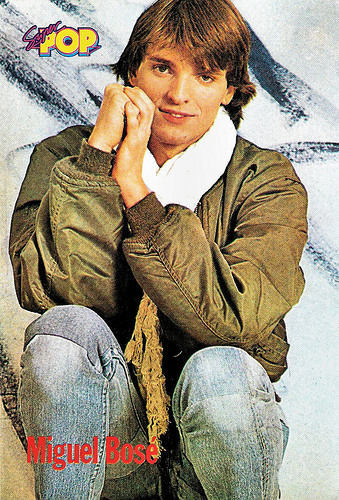
Spanish postcard in the series Tus Idolos by Super Pop Tu revista.
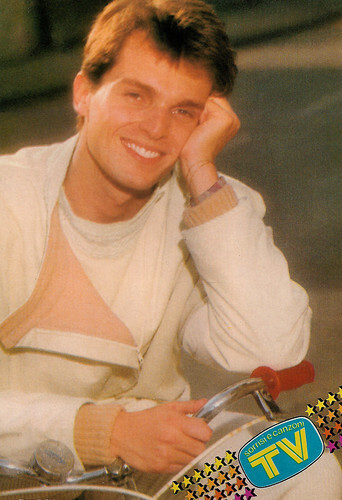
Italian postcard by Sorrisi e Canzoni TV, 1981.
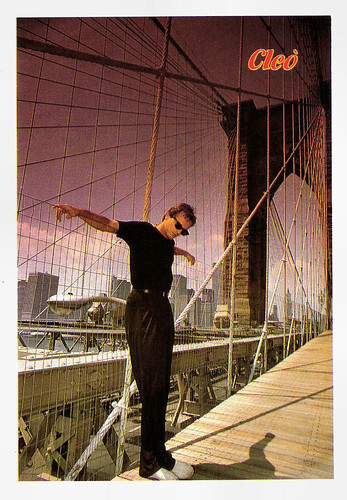
Italian postcard by Edizioni Cloé.
Suspiria
Miguel Bosé was born Miguel Luchino González Borlani in 1956 in San Fernando Hospital in Panama City, Panama. He was the son of Italian actress Lucia Bosè and bullfighter Luis Miguel Dominguín. He grew up in an environment surrounded by art and culture. Close friends of his family were Pablo Picasso and Ernest Hemingway. His godfather was Luchino Visconti and Pablo Picasso was the godfather of his sister Paola Dominguin.
In 1971, propelled by his famous family and their friends, Bosé started a career as an actor. He appeared in small roles in Italian films like the war-comedy Gli eroi/The Heroes (Duccio Tessari, 1973) and the exploitation crime film La Orca/Snatch (Eriprando Visconti, 1976) with Michele Placido.
Bosé quickly won spots on the basis of his talent and good looks alone, rather than his name, and he studied serious acting as well as dancing and singing. In 1975 he started exploring his talents as a singer. With the assistance of Camilo Blanes, he recorded his first singles.
Two years later, in 1977, Bosé signed a contract with CBS Records, and he remained with them until 1984. Between 1977 and 1982, Bosè was a major teen idol in Italy (where he sang in Italian and English) and in Spain (where he sang in Spanish). He had 7 top ten hits in a disco/new wave trend that earned him a secure spot in every televised song festival held in Southern Europe.
During this period, he continued to play in films, including the Spanish production Retrato de Familia/Family Portrait (Antonio Giménez-Rico, 1976), the Spaghetti Western California (Michele Lupo, 1977) starring Giuliano Gemma , and the classic Giallo Suspiria/Sighs (Dario Argento, 1977) with Jessica Harper.
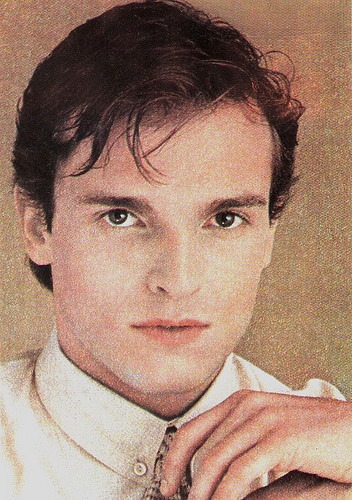
Romanian postcard by Casa Filmului Acin.
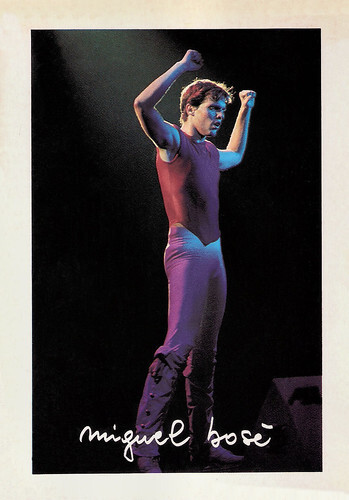
Italian postcard in the photo d'arte series by Grafiche Corsini, Firenze, no. C2. Photo: Riccardo Bettini.
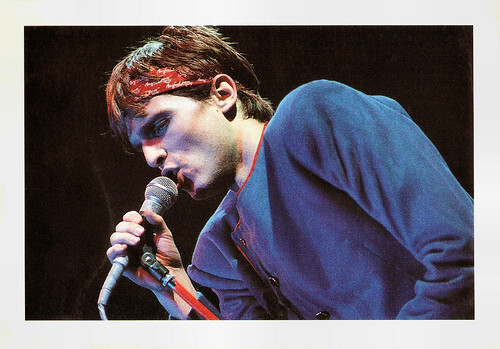
Italian postcard. Photo: Omega.
High heels
In 1983, Miguel Bosé’s star had severely waned in Italy, and he rarely performed there again until the 2000s. In 1983, 1984, and 1985, Bosé participated in the Llena Tu Cabeza De Rock television specials on Puerto Rico WAPA-TV. In 1985 his song 'Amante bandido' rose to the top of the charts all over Latin America and in Spain. The video to that song also became one of the most widely seen Spanish music videos, with Bose playing both a Superman-style superhero and an Indiana Jones-type of adventurer in it.
He revived his international film career with roles in the Italian comedy L'avaro/The Miser (Tonino Cervi, 1990), starring Alberto Sordi and Laura Antonelli , and the Spanish melodrama Tacones lejanos/High Heels (Pedro Almodóvar, 1991) starring Marisa Paredes and Victoria Abril. In Tacones lejanos, the male lead was difficult to cast. The actor had to be believable in drag and as a judge. When the role eventually went to Bosé, his casting was a cause célèbre of the film publicity. The film was enormously successful in Spain and eventually, it came second in terms of box-office takings to Mujeres al borde de un ataque de nervios/Women on the Verge of a Nervous Breakdown (1988) among Almodóvar's films released up to that point. High Heels was also a success in France and Italy but did less well in other countries.
Bosé then played the lead in the French drama Mazeppa (Bartabas, 1993) and the excellent French period film La Reine Margot/Queen Margot (Patrice Chéreau, 1994) featuring Isabelle Adjani and Vincent Perez . His later films were less successful. Musically, he would return to the top in Italy in 1994, by winning the musical event Festivalbar for the third time. In the following decade, Bosé's popularity continued undiminished as he released four more studio albums and two live albums. In 2007, to celebrate his 30 years as a singer, he released 'Papito', an album that contains remakes of his previous songs, re-interpreted in duets with artists like Juanes, Alejandro Sanz, Laura Pausini, Shakira, Ricky Martin, and Michael Stipe from R.E.M.
His hit single 'Nena', featuring Mexican superstar Paulina Rubio, was nominated for a Latin Grammy for best song and became the best-selling download in Spain in 2007. In 2008, Colombian President Álvaro Uribe offered him Colombian citizenship because of his efforts towards peace in Colombia, including his participation in two concerts in 2008. In 2010 he received Colombian citizenship. In 2012 he released the album 'Papitwo', a follow-up to his successful 'Papito'. In 2016 he released 'Bosé MTV Unplugged', a live album that contains remakes of his previous songs as duets with Sasha Sokol, Pablo Alborán, Marco Antonio Solís, Fonseca, along with many other singers. Miguel Bosé performed in the 2018 Viña del Mar International Song Festival, to a sold-out audience. His latest screen appearance was a guest role in La Casa de las Flores/The House of Flowers (2020), a Mexican black comedy-drama television series created by Manolo Caro for Netflix.
Bosé was in a long-term relationship with sculptor Ignacio Palau from 1992 to 2018. In 2011, Bosé's twins Diego and Tadeo were born via surrogacy. Seven months later, Ivo and Telmo were born through the same method with Palau's biological gene. Zac Johnson at AllMusic : "Defying the contemporary formula for pop success, his music has been described as a global fusion of many musical influences. At the centre of his music is all the passion and expression of a Latin artist, yet Miguel Bosé has constantly incorporated more diverse musical elements than many of the genre's crossover pop stars."
Trailer for the Spaghetti Western California (Michele Lupo, 1977). Source: The Spaghetti Western Database (YouTube).
Trailer for Tacones lejanos/High Heels (Pedro Almodóvar, 1991). Source: Eldeseopc (YouTube).
A video clip for the song Nena (2007). Source: Miguel Bosé (YouTube).
A video clip for the song Encanto of Miguel Bosé's album Amo (2014). Source: Miguel Bosé (YouTube).
Sources: Zac Johnson (AllMusic), Wikipedia and .

Spanish postcard in the series Tus Idolos by Super Pop Tu revista.

Italian postcard by Sorrisi e Canzoni TV, 1981.

Italian postcard by Edizioni Cloé.
Suspiria
Miguel Bosé was born Miguel Luchino González Borlani in 1956 in San Fernando Hospital in Panama City, Panama. He was the son of Italian actress Lucia Bosè and bullfighter Luis Miguel Dominguín. He grew up in an environment surrounded by art and culture. Close friends of his family were Pablo Picasso and Ernest Hemingway. His godfather was Luchino Visconti and Pablo Picasso was the godfather of his sister Paola Dominguin.
In 1971, propelled by his famous family and their friends, Bosé started a career as an actor. He appeared in small roles in Italian films like the war-comedy Gli eroi/The Heroes (Duccio Tessari, 1973) and the exploitation crime film La Orca/Snatch (Eriprando Visconti, 1976) with Michele Placido.
Bosé quickly won spots on the basis of his talent and good looks alone, rather than his name, and he studied serious acting as well as dancing and singing. In 1975 he started exploring his talents as a singer. With the assistance of Camilo Blanes, he recorded his first singles.
Two years later, in 1977, Bosé signed a contract with CBS Records, and he remained with them until 1984. Between 1977 and 1982, Bosè was a major teen idol in Italy (where he sang in Italian and English) and in Spain (where he sang in Spanish). He had 7 top ten hits in a disco/new wave trend that earned him a secure spot in every televised song festival held in Southern Europe.
During this period, he continued to play in films, including the Spanish production Retrato de Familia/Family Portrait (Antonio Giménez-Rico, 1976), the Spaghetti Western California (Michele Lupo, 1977) starring Giuliano Gemma , and the classic Giallo Suspiria/Sighs (Dario Argento, 1977) with Jessica Harper.

Romanian postcard by Casa Filmului Acin.

Italian postcard in the photo d'arte series by Grafiche Corsini, Firenze, no. C2. Photo: Riccardo Bettini.

Italian postcard. Photo: Omega.
High heels
In 1983, Miguel Bosé’s star had severely waned in Italy, and he rarely performed there again until the 2000s. In 1983, 1984, and 1985, Bosé participated in the Llena Tu Cabeza De Rock television specials on Puerto Rico WAPA-TV. In 1985 his song 'Amante bandido' rose to the top of the charts all over Latin America and in Spain. The video to that song also became one of the most widely seen Spanish music videos, with Bose playing both a Superman-style superhero and an Indiana Jones-type of adventurer in it.
He revived his international film career with roles in the Italian comedy L'avaro/The Miser (Tonino Cervi, 1990), starring Alberto Sordi and Laura Antonelli , and the Spanish melodrama Tacones lejanos/High Heels (Pedro Almodóvar, 1991) starring Marisa Paredes and Victoria Abril. In Tacones lejanos, the male lead was difficult to cast. The actor had to be believable in drag and as a judge. When the role eventually went to Bosé, his casting was a cause célèbre of the film publicity. The film was enormously successful in Spain and eventually, it came second in terms of box-office takings to Mujeres al borde de un ataque de nervios/Women on the Verge of a Nervous Breakdown (1988) among Almodóvar's films released up to that point. High Heels was also a success in France and Italy but did less well in other countries.
Bosé then played the lead in the French drama Mazeppa (Bartabas, 1993) and the excellent French period film La Reine Margot/Queen Margot (Patrice Chéreau, 1994) featuring Isabelle Adjani and Vincent Perez . His later films were less successful. Musically, he would return to the top in Italy in 1994, by winning the musical event Festivalbar for the third time. In the following decade, Bosé's popularity continued undiminished as he released four more studio albums and two live albums. In 2007, to celebrate his 30 years as a singer, he released 'Papito', an album that contains remakes of his previous songs, re-interpreted in duets with artists like Juanes, Alejandro Sanz, Laura Pausini, Shakira, Ricky Martin, and Michael Stipe from R.E.M.
His hit single 'Nena', featuring Mexican superstar Paulina Rubio, was nominated for a Latin Grammy for best song and became the best-selling download in Spain in 2007. In 2008, Colombian President Álvaro Uribe offered him Colombian citizenship because of his efforts towards peace in Colombia, including his participation in two concerts in 2008. In 2010 he received Colombian citizenship. In 2012 he released the album 'Papitwo', a follow-up to his successful 'Papito'. In 2016 he released 'Bosé MTV Unplugged', a live album that contains remakes of his previous songs as duets with Sasha Sokol, Pablo Alborán, Marco Antonio Solís, Fonseca, along with many other singers. Miguel Bosé performed in the 2018 Viña del Mar International Song Festival, to a sold-out audience. His latest screen appearance was a guest role in La Casa de las Flores/The House of Flowers (2020), a Mexican black comedy-drama television series created by Manolo Caro for Netflix.
Bosé was in a long-term relationship with sculptor Ignacio Palau from 1992 to 2018. In 2011, Bosé's twins Diego and Tadeo were born via surrogacy. Seven months later, Ivo and Telmo were born through the same method with Palau's biological gene. Zac Johnson at AllMusic : "Defying the contemporary formula for pop success, his music has been described as a global fusion of many musical influences. At the centre of his music is all the passion and expression of a Latin artist, yet Miguel Bosé has constantly incorporated more diverse musical elements than many of the genre's crossover pop stars."
Trailer for the Spaghetti Western California (Michele Lupo, 1977). Source: The Spaghetti Western Database (YouTube).
Trailer for Tacones lejanos/High Heels (Pedro Almodóvar, 1991). Source: Eldeseopc (YouTube).
A video clip for the song Nena (2007). Source: Miguel Bosé (YouTube).
A video clip for the song Encanto of Miguel Bosé's album Amo (2014). Source: Miguel Bosé (YouTube).
Sources: Zac Johnson (AllMusic), Wikipedia and .
Published on November 05, 2023 22:00
November 4, 2023
Art Acord
American silent star Art Acord (1890-1931) was nicknamed "The Cowpuncher King". He was a rodeo champion and as a film star, he was known for such Westerns as The White Horseman (1921), The Set-Up (1926), and Set Free (1927).
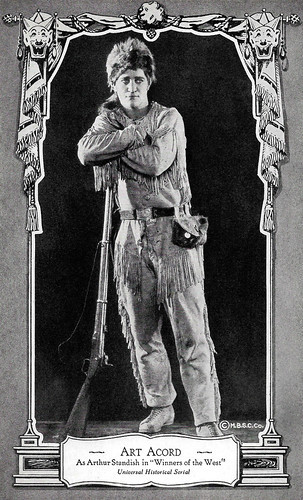
American postcard by Max B. Sheffer Card Co., Chicago (M.B.S.C.Co.). Photo: Universal. Art Acord as Arthur Standish in Winners of the West (Edward Laemmle, 1921). Caption: Universal Historical Serial.

Spanish collectors card by Chocolate Pi, Barcelona, no. 5 of 54 cromo cards. Photo: Cinematografica Verdaguer, Barcelona. Art Acord in the lost American western serial The Moonriders (B. Reeves Eason, Theodore Wharton, 1920), distributed by Universal. It had 18 episodes and the Spanish release title was Los Jinetes de la Luna.
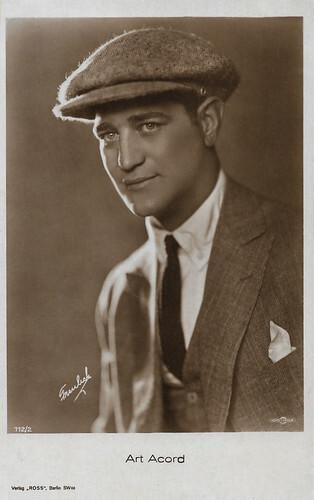
German postcard by Ross Verlag, no. 712/2, 1925-1926. Photo: Roman Freulich / Universal.
The Mormon cowboy
Art Acord was born as Arthemus Ward Acord in 1890 in Stillwater, Oklahoma, USA. Some sources believe it to be in Utah, with the family then moving to Stillwater. His parents, Valentine Louis Acord and Mary Amelia Acord (née Pedersen) were Utah pioneers and members of The Church of Jesus Christ of Latter-day Saints (the Mormon Church).
At the age of nine, he was a full-time wrangler on a ranch near town. As his riding skills increased, Acord began rodeo competitions around the country. In 1909 he was hired by the Dick Stanley-Bud Atkinson Wild West Show to perform the daring riding stunts for which he had become famous.
The handsome young man also started in the motion picture business in 1909 as a stuntman in Westerns. He was sometimes called the "Mormon cowboy". Five years later he began working for Mutual under the name Buck Parvin. He went on to become a noted actor in silent Westerns. In 1911, he worked with the Wild West show of William F. Cody. His horse was named Raven. he worked for a time for the Miller Brothers' travelling 101 Ranch Wild West Show. It was with the 101 that he became friends with Tom Mix , Yakima Canutt, 'Broncho Billy' Anderson, and Hoot Gibson .
In 1912, he won the Steer Bulldogging world championship. He won that same World Championship title again in 1916, defeating challenger and friend Hoot Gibson . His professional rodeo skills made him a believable and "real" cowboy on the screen. He had a small part in the early classic The Squaw Man (Oscar Apfel, Cecil B. DeMille, 1914), starring Dustin Farnum.
In 1915 his breakthrough film role came in the series Buck Parvin in the Movies (Charles E. van Loan, 1915). He enlisted in the U.S. Army in World War I and served overseas. He was awarded the Croix de Guerre by the French government for his bravery. After the war ended, he returned to films. He also joined the Dick Stanley Wild West Show in 1919.

Spanish collectors card by Chocolate Pi, Barcelona, no. 7 of 54 cromo cards. Photo: Cinematografica Verdaguer, Barcelona. Art Acord (right) in the lost American western serial The Moonriders (B. Reeves Eason, Theodore Wharton, 1920), distributed by Universal. It had 18 episodes and the Spanish release title was Los Jinetes de la Luna.

Spanish collectors card by Chocolate Pi, Barcelona, no. 11 of 54 cromo cards. Photo: Cinematografica Verdaguer, Barcelona. Beatrice Dominguez, Art Acord, George Field, Charles Newton, and Mildred Moore in The Moonriders (B. Reeves Eason, Theodore Wharton, 1920).

Spanish collectors card by Chocolate Pi, Barcelona, no. 24 of 54 cromo cards. Photo: Cinematografica Verdaguer, Barcelona. Mildred Moore, Charles Newton, and Art Acord in The Moonriders (B. Reeves Eason, Theodore Wharton, 1920).
A heavy drinking problem
During the 1920s, Art Acord became one of Universal's star cowboys. In total, he made over 100 films, most of which are now considered lost. Because of a heavy drinking problem and his inability to adapt to the advent of talkies, his film career fell apart. By the time of his last silent film, The White Outlaw (Robert J. Horner, 1929), he looked tired and worn.
His lifelong fight with alcoholism had taken its toll. He would sometimes disappear for days at a time, causing a shutdown in film production. The major studios eventually lost interest, leaving only the low-budget film companies to work with him.
Later, Acord worked in rodeo roadshows and as a miner in Mexico. He was married to Edythe Sterling, former actress Edna Nores, and actress Louise Lorraine. All three marriages ended in divorce.
He then relocated to Mexico where he worked in a rodeo. In 1931 Art Acord was found dead in his Chihuahua, Mexico hotel room. He died of cyanide poisoning. Although the Mexican police officially listed his death as a suicide, many of his friends over the years insisted that he had been murdered by a Mexican politician who had caught Acord having an affair with his wife.
Acord was interred at Forest Lawn Memorial Park Cemetery in Glendale, California. In 1960, he was awarded a Star on the Hollywood Walk of Fame. Although most of his films are lost, 20 have been discovered in private collections and archives.
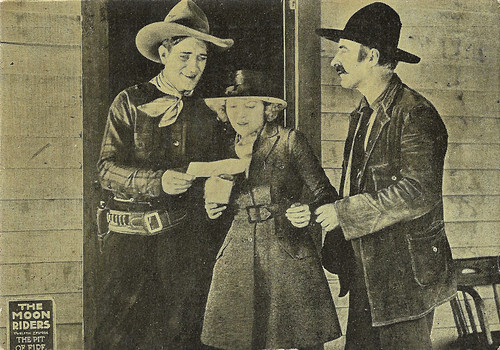
Spanish collectors card by Chocolate Pi, Barcelona, no. 37 of 54 cromo cards. Photo: Cinematografica Verdaguer, Barcelona. Art Acord, Mildred Moore, and Charles Newton in The Moonriders (B. Reeves Eason, Theodore Wharton, 1920).
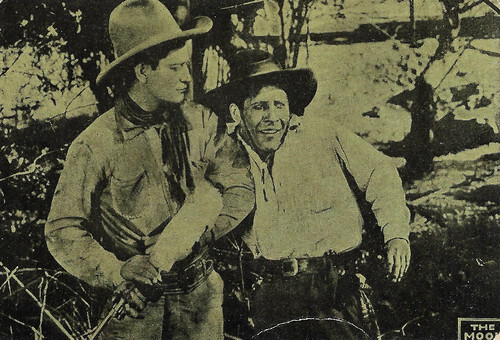
Spanish collectors card by Chocolate Pi, Barcelona, no. 44 of 54 cromo cards. Photo: Cinematografica Verdaguer, Barcelona. Art Acord (left) in The Moonriders (B. Reeves Eason, Theodore Wharton, 1920).
Sources: Sandra Brennan (AllMovie), Encyclopedia of Oklahoma History & Culture, Wikipedia, and .

American postcard by Max B. Sheffer Card Co., Chicago (M.B.S.C.Co.). Photo: Universal. Art Acord as Arthur Standish in Winners of the West (Edward Laemmle, 1921). Caption: Universal Historical Serial.

Spanish collectors card by Chocolate Pi, Barcelona, no. 5 of 54 cromo cards. Photo: Cinematografica Verdaguer, Barcelona. Art Acord in the lost American western serial The Moonriders (B. Reeves Eason, Theodore Wharton, 1920), distributed by Universal. It had 18 episodes and the Spanish release title was Los Jinetes de la Luna.

German postcard by Ross Verlag, no. 712/2, 1925-1926. Photo: Roman Freulich / Universal.
The Mormon cowboy
Art Acord was born as Arthemus Ward Acord in 1890 in Stillwater, Oklahoma, USA. Some sources believe it to be in Utah, with the family then moving to Stillwater. His parents, Valentine Louis Acord and Mary Amelia Acord (née Pedersen) were Utah pioneers and members of The Church of Jesus Christ of Latter-day Saints (the Mormon Church).
At the age of nine, he was a full-time wrangler on a ranch near town. As his riding skills increased, Acord began rodeo competitions around the country. In 1909 he was hired by the Dick Stanley-Bud Atkinson Wild West Show to perform the daring riding stunts for which he had become famous.
The handsome young man also started in the motion picture business in 1909 as a stuntman in Westerns. He was sometimes called the "Mormon cowboy". Five years later he began working for Mutual under the name Buck Parvin. He went on to become a noted actor in silent Westerns. In 1911, he worked with the Wild West show of William F. Cody. His horse was named Raven. he worked for a time for the Miller Brothers' travelling 101 Ranch Wild West Show. It was with the 101 that he became friends with Tom Mix , Yakima Canutt, 'Broncho Billy' Anderson, and Hoot Gibson .
In 1912, he won the Steer Bulldogging world championship. He won that same World Championship title again in 1916, defeating challenger and friend Hoot Gibson . His professional rodeo skills made him a believable and "real" cowboy on the screen. He had a small part in the early classic The Squaw Man (Oscar Apfel, Cecil B. DeMille, 1914), starring Dustin Farnum.
In 1915 his breakthrough film role came in the series Buck Parvin in the Movies (Charles E. van Loan, 1915). He enlisted in the U.S. Army in World War I and served overseas. He was awarded the Croix de Guerre by the French government for his bravery. After the war ended, he returned to films. He also joined the Dick Stanley Wild West Show in 1919.

Spanish collectors card by Chocolate Pi, Barcelona, no. 7 of 54 cromo cards. Photo: Cinematografica Verdaguer, Barcelona. Art Acord (right) in the lost American western serial The Moonriders (B. Reeves Eason, Theodore Wharton, 1920), distributed by Universal. It had 18 episodes and the Spanish release title was Los Jinetes de la Luna.

Spanish collectors card by Chocolate Pi, Barcelona, no. 11 of 54 cromo cards. Photo: Cinematografica Verdaguer, Barcelona. Beatrice Dominguez, Art Acord, George Field, Charles Newton, and Mildred Moore in The Moonriders (B. Reeves Eason, Theodore Wharton, 1920).

Spanish collectors card by Chocolate Pi, Barcelona, no. 24 of 54 cromo cards. Photo: Cinematografica Verdaguer, Barcelona. Mildred Moore, Charles Newton, and Art Acord in The Moonriders (B. Reeves Eason, Theodore Wharton, 1920).
A heavy drinking problem
During the 1920s, Art Acord became one of Universal's star cowboys. In total, he made over 100 films, most of which are now considered lost. Because of a heavy drinking problem and his inability to adapt to the advent of talkies, his film career fell apart. By the time of his last silent film, The White Outlaw (Robert J. Horner, 1929), he looked tired and worn.
His lifelong fight with alcoholism had taken its toll. He would sometimes disappear for days at a time, causing a shutdown in film production. The major studios eventually lost interest, leaving only the low-budget film companies to work with him.
Later, Acord worked in rodeo roadshows and as a miner in Mexico. He was married to Edythe Sterling, former actress Edna Nores, and actress Louise Lorraine. All three marriages ended in divorce.
He then relocated to Mexico where he worked in a rodeo. In 1931 Art Acord was found dead in his Chihuahua, Mexico hotel room. He died of cyanide poisoning. Although the Mexican police officially listed his death as a suicide, many of his friends over the years insisted that he had been murdered by a Mexican politician who had caught Acord having an affair with his wife.
Acord was interred at Forest Lawn Memorial Park Cemetery in Glendale, California. In 1960, he was awarded a Star on the Hollywood Walk of Fame. Although most of his films are lost, 20 have been discovered in private collections and archives.

Spanish collectors card by Chocolate Pi, Barcelona, no. 37 of 54 cromo cards. Photo: Cinematografica Verdaguer, Barcelona. Art Acord, Mildred Moore, and Charles Newton in The Moonriders (B. Reeves Eason, Theodore Wharton, 1920).

Spanish collectors card by Chocolate Pi, Barcelona, no. 44 of 54 cromo cards. Photo: Cinematografica Verdaguer, Barcelona. Art Acord (left) in The Moonriders (B. Reeves Eason, Theodore Wharton, 1920).
Sources: Sandra Brennan (AllMovie), Encyclopedia of Oklahoma History & Culture, Wikipedia, and .
Published on November 04, 2023 23:00
November 3, 2023
Play that song again
We like requests. Greg, one of our friends at Flickr, is fascinated by female film stars playing musical instruments and asked us to post some fun postcards of them. We were surprised about what we found and would like to share it here. For today, we had planned a La Collectionneuse post on Grace Moore but technical problems forced us to postpone that one. So instead, here are 20 film women playing musical instruments. For the fun of it.
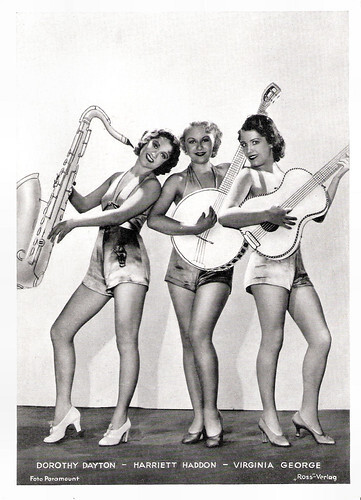
Big German card by Ross Verlag. Photo: Paramount. From left to right the American chorus girls Dorothy Dayton (1908–1997), Harriett Haddon (1915–1999) and Virginia George (?-?). They all appeared - uncredited - in College Rhythm (Norman Tautog, 1934).
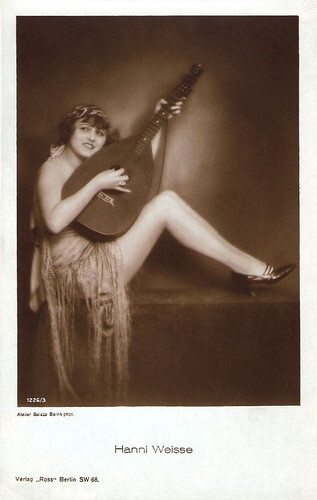
German postcard by Ross Verlag, no. 1226/3, 1927-1928. Photo: Atelier Balázs, Berlin.
German actress Hanni Weisse (1892-1967) belonged to the great film divas of the early German silent film. She was able to maintain her stardom till the 1920s.
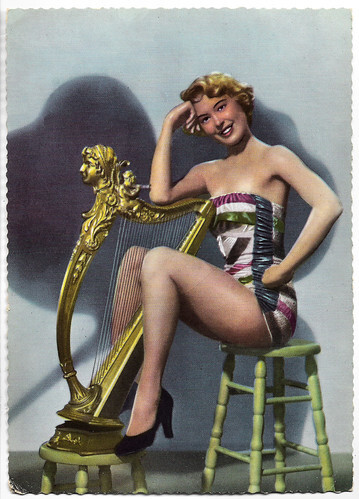
Dutch postcard by I.F.P.A., no. 12.
American musical actress Barbara Ruick (1930-1974) was "A bundle of bright sunshine and unabashed energy", according to Gary Brumburgh at IMDb. Ruick delighted audiences for over two decades. The brown-eyed singer/actress who admittedly came up short in the dancing department nevertheless toyed with top musical stardom in mid-1950s films and almost nabbed it. Her most important film role was in Rodgers and Hammerstein's classic Carousel (1956), Brumburgh: "A vivacious beauty whose sparkling, fresh-faced appeal reminded one instantly of a Mitzi Gaynor or Vera-Ellen", Barbara's death at age 43 robbed Hollywood of a tried-and-true talent.
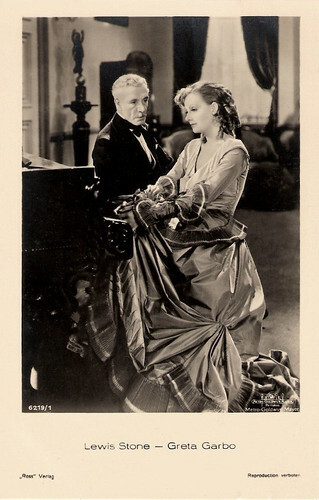
German postcard by Ross Verlag, no. 6219/1, 1931-1932. Photo: Metro-Goldwyn-Mayer (MGM). Greta Garbo and Lewis Stone in Romance (Clarence Brown, 1930).
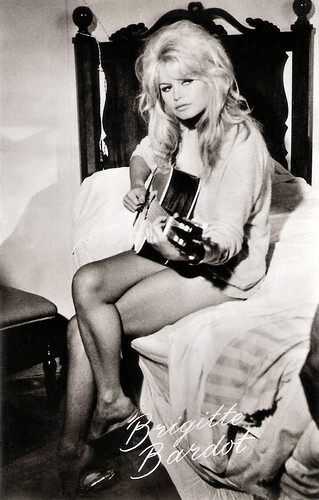
Dutch postcard by Uitgeverij Takken, Utrecht, no. AX 4791.
Beautiful French actress Brigitte Bardot (1934) was the sex kitten of the European film industry. BB starred in 48 films, performed in numerous musical shows, and recorded 80 songs. After her retirement in 1973, she established herself as an animal rights activist and made vegetarianism sexy.
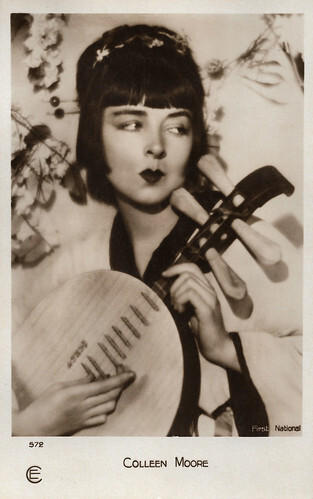
French postcard by Cinémagazine-Edition, no. 572. Photo: Freulich /First National. The photo was specially posed for Motion Picture magazine in 1928.
American actress Colleen Moore (1899-1988) was a star of the silent screen who appeared in about 100 films beginning in 1917. During the 1920s, she put her stamp on American social history, creating in dozens of films the image of the wide-eyed, insouciant flapper with her bobbed hair and short skirts.
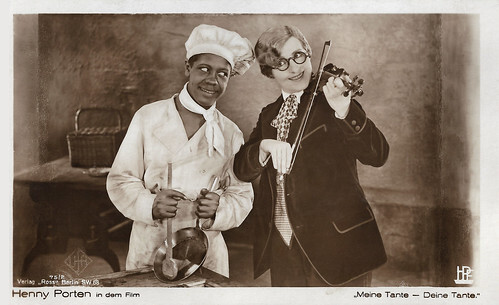
German postcard by Ross Verlag, no. 75/2. Photo: A. Schmoll, Berlin / Henny-Porten-Film. Henny Porten in Meine Tante - deine Tante (Carl Froehlich, 1927).

Small German collectors card in the 'Der künstlerische Tanz' series by Eckstein-Halpaus, Dresden, group 12 (Tanz-Artistik), no. 252. Photo: Alex Binder.
Hungarian actress, dancer and singer Rose Barsony (1909-1977) appeared in 16 films from 1929 to 1938, and in one more in 1957. The soubrette was a popular star of the operettas by Paul Abraham.
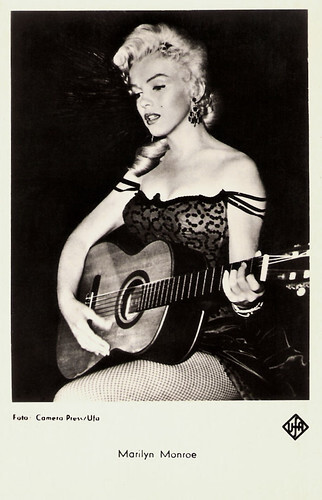
French postcard by Editions P.I., Paris, no. FK 3969. Photo: Camera Press / Ufa. Marilyn Monroe in River of No Return (Otto Preminger, 1954).
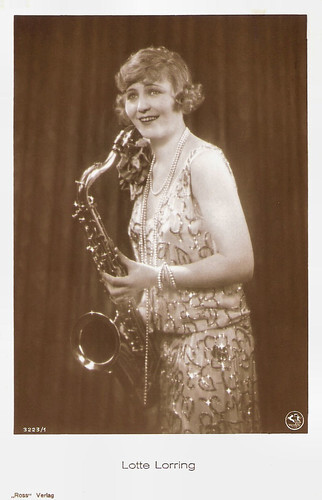
German postcard by Ross Verlag, no. 3223/1, 1928-1929. Photo: Phoebus Film.
German actress and singer Lotte Lorring (1893-1939) started as an operetta singer in provincial theatres. Between 1920 and 1935, she played both in support and leading roles in German silent and sound films. Incidentally, she appeared in international productions.
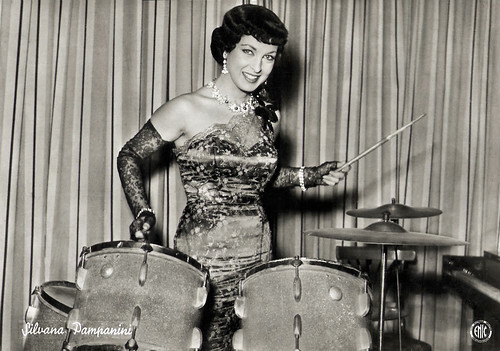
Italian postcard by Bromofoto, Milano,, no. 970. Photo: ENIC.
Italian diva Silvana Pampanini (1925-2016) gained enormous popularity in the 1950s and 1960s. In the early 1950s, before Sophia Loren and Gina Lollobrigida reached stardom, Pampanini was one of the most well-known symbols of Italian beauty.
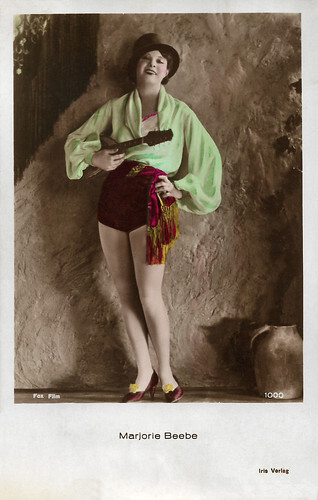
Austrian postcard by Iris Verlag, no. 1000. Photo: Fox Film.
Marjorie Beebe (1908-1983) was an American film actress. The Fox comedy The Farmer's Daughter (Arthur Rosson, 1928) made her a star and in the early 1930s, she was the star in many Mack Sennett films.
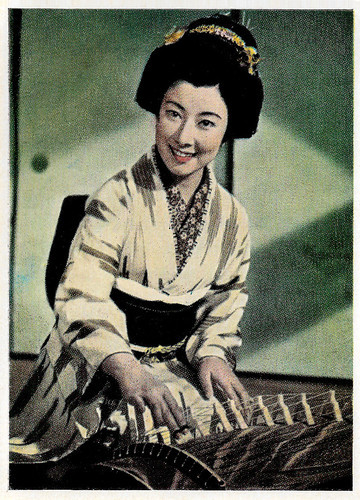
German collectors card in the "Filmstars von Hollywood bis Tokio" series III.
Fujiko Yamamoto (1931) is a Japanese film and stage actress. She appeared in over 100 films between 1953 and 1963. She was one of the top actresses of the Daei studio.
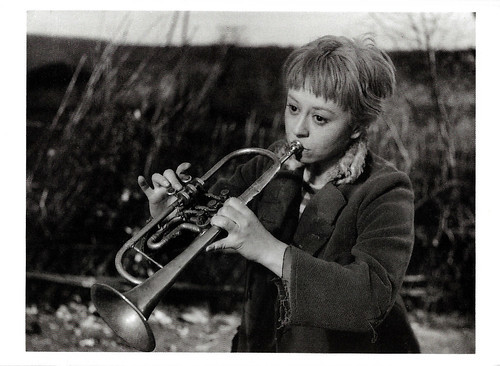
Swiss postcard by Collection Cinémathéque Suisse, Lausanne / News Productions, Baulmes, no. 56518. Photo: Ponti - De Laurentis. Giulietta Masina as Gelsomina in La Strada (Federico Fellini, 1954).
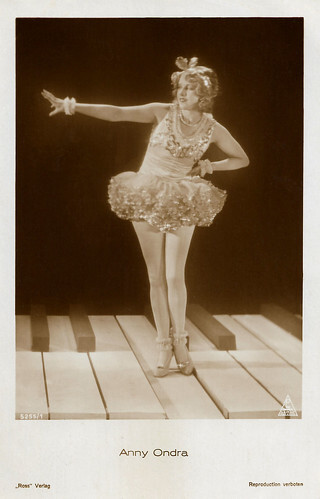
German postcard by Ross Verlag, no. 5255/1, 1930-1931. Photo: Ondra-Lamac-Film. Anny Ondra in Die vom Rummelplatz/Those of the Sideshow (Karel Lamac, 1930).
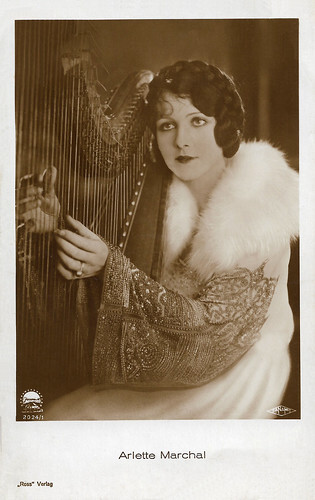
German postcard by Ross Verlag, no. 2024/1, 1927-1928. Photo: Paramount / Fanamet.
Elegant French actress Arlette Marchal (1902-1984) started out as a fashion model. Between 1922 and 1951 she starred in 41 European and American films. From the 1950s onwards, she dedicated herself mostly to her fashion enterprise.
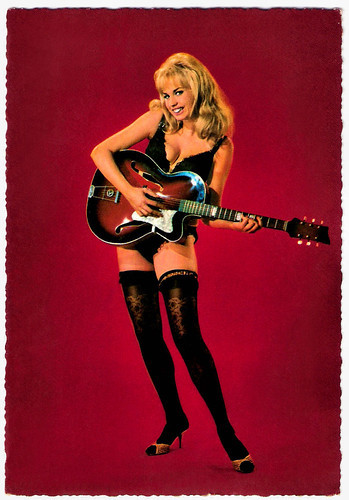
German Postcard by Krüger, no. 900/272.
Film and TV actress Barbara Valentin (1940-2002) was dubbed the 'German Jayne Mansfield' and a 'Scandal Magnet'. Her résumé includes sexploitation but also art films directed by Rainer Werner Fassbinder. Her private life was fodder for the tabloids. Pop star Freddie Mercury was ‘the love of her life’.
For Greg! Check out our Flickr album Let's make music.

Big German card by Ross Verlag. Photo: Paramount. From left to right the American chorus girls Dorothy Dayton (1908–1997), Harriett Haddon (1915–1999) and Virginia George (?-?). They all appeared - uncredited - in College Rhythm (Norman Tautog, 1934).

German postcard by Ross Verlag, no. 1226/3, 1927-1928. Photo: Atelier Balázs, Berlin.
German actress Hanni Weisse (1892-1967) belonged to the great film divas of the early German silent film. She was able to maintain her stardom till the 1920s.

Dutch postcard by I.F.P.A., no. 12.
American musical actress Barbara Ruick (1930-1974) was "A bundle of bright sunshine and unabashed energy", according to Gary Brumburgh at IMDb. Ruick delighted audiences for over two decades. The brown-eyed singer/actress who admittedly came up short in the dancing department nevertheless toyed with top musical stardom in mid-1950s films and almost nabbed it. Her most important film role was in Rodgers and Hammerstein's classic Carousel (1956), Brumburgh: "A vivacious beauty whose sparkling, fresh-faced appeal reminded one instantly of a Mitzi Gaynor or Vera-Ellen", Barbara's death at age 43 robbed Hollywood of a tried-and-true talent.

German postcard by Ross Verlag, no. 6219/1, 1931-1932. Photo: Metro-Goldwyn-Mayer (MGM). Greta Garbo and Lewis Stone in Romance (Clarence Brown, 1930).

Dutch postcard by Uitgeverij Takken, Utrecht, no. AX 4791.
Beautiful French actress Brigitte Bardot (1934) was the sex kitten of the European film industry. BB starred in 48 films, performed in numerous musical shows, and recorded 80 songs. After her retirement in 1973, she established herself as an animal rights activist and made vegetarianism sexy.

French postcard by Cinémagazine-Edition, no. 572. Photo: Freulich /First National. The photo was specially posed for Motion Picture magazine in 1928.
American actress Colleen Moore (1899-1988) was a star of the silent screen who appeared in about 100 films beginning in 1917. During the 1920s, she put her stamp on American social history, creating in dozens of films the image of the wide-eyed, insouciant flapper with her bobbed hair and short skirts.

German postcard by Ross Verlag, no. 75/2. Photo: A. Schmoll, Berlin / Henny-Porten-Film. Henny Porten in Meine Tante - deine Tante (Carl Froehlich, 1927).

Small German collectors card in the 'Der künstlerische Tanz' series by Eckstein-Halpaus, Dresden, group 12 (Tanz-Artistik), no. 252. Photo: Alex Binder.
Hungarian actress, dancer and singer Rose Barsony (1909-1977) appeared in 16 films from 1929 to 1938, and in one more in 1957. The soubrette was a popular star of the operettas by Paul Abraham.

French postcard by Editions P.I., Paris, no. FK 3969. Photo: Camera Press / Ufa. Marilyn Monroe in River of No Return (Otto Preminger, 1954).

German postcard by Ross Verlag, no. 3223/1, 1928-1929. Photo: Phoebus Film.
German actress and singer Lotte Lorring (1893-1939) started as an operetta singer in provincial theatres. Between 1920 and 1935, she played both in support and leading roles in German silent and sound films. Incidentally, she appeared in international productions.

Italian postcard by Bromofoto, Milano,, no. 970. Photo: ENIC.
Italian diva Silvana Pampanini (1925-2016) gained enormous popularity in the 1950s and 1960s. In the early 1950s, before Sophia Loren and Gina Lollobrigida reached stardom, Pampanini was one of the most well-known symbols of Italian beauty.

Austrian postcard by Iris Verlag, no. 1000. Photo: Fox Film.
Marjorie Beebe (1908-1983) was an American film actress. The Fox comedy The Farmer's Daughter (Arthur Rosson, 1928) made her a star and in the early 1930s, she was the star in many Mack Sennett films.

German collectors card in the "Filmstars von Hollywood bis Tokio" series III.
Fujiko Yamamoto (1931) is a Japanese film and stage actress. She appeared in over 100 films between 1953 and 1963. She was one of the top actresses of the Daei studio.

Swiss postcard by Collection Cinémathéque Suisse, Lausanne / News Productions, Baulmes, no. 56518. Photo: Ponti - De Laurentis. Giulietta Masina as Gelsomina in La Strada (Federico Fellini, 1954).

German postcard by Ross Verlag, no. 5255/1, 1930-1931. Photo: Ondra-Lamac-Film. Anny Ondra in Die vom Rummelplatz/Those of the Sideshow (Karel Lamac, 1930).

German postcard by Ross Verlag, no. 2024/1, 1927-1928. Photo: Paramount / Fanamet.
Elegant French actress Arlette Marchal (1902-1984) started out as a fashion model. Between 1922 and 1951 she starred in 41 European and American films. From the 1950s onwards, she dedicated herself mostly to her fashion enterprise.

German Postcard by Krüger, no. 900/272.
Film and TV actress Barbara Valentin (1940-2002) was dubbed the 'German Jayne Mansfield' and a 'Scandal Magnet'. Her résumé includes sexploitation but also art films directed by Rainer Werner Fassbinder. Her private life was fodder for the tabloids. Pop star Freddie Mercury was ‘the love of her life’.
For Greg! Check out our Flickr album Let's make music.
Published on November 03, 2023 23:00
November 2, 2023
Burt Reynolds
American film actor Burt Reynolds (1936-2018) became famous for his many roles with a macho appearance. His role in Deliverance (1972) made him a star. The 1970s saw many successes, especially as 'Bandit' in Smokey and the Bandit (1977). He received an Oscar nomination for Best Male Supporting Actor for Boogie Nights (1998). Reynolds himself directed and produced a few films.
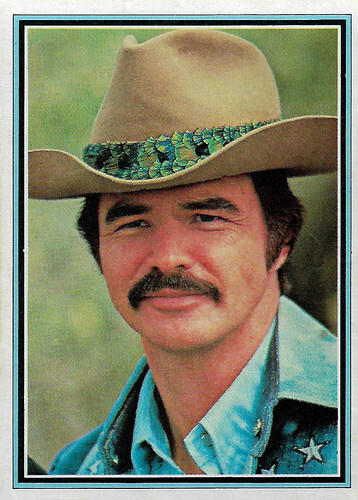
Spanish collectors card in the Telestars series by Ediciones Este, Barcelona, no. 198. Burt Reynolds in Hooper (Hal Needham, 1978).
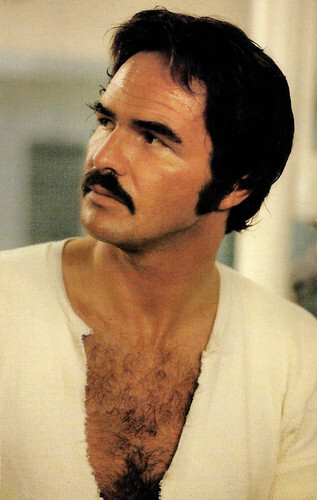
American postcard by Coral-Lee, Rancho Cordova, CA, no. Personality # 81, SC176971063. Photo: Steve Schapiro / Sygma.
A canoe trip that turns into a nightmare
Burton Leon 'Burt' Reynolds was born in Lansing, Michigan, in 1936. His parents were Burton Milo Reynolds), and Harriette Fernette 'Fern' Reynolds née Miller. His paternal grandmother was Cherokee. After World War II, his family moved to Riviera Beach, Florida, where his father was chief of police. In his youth, Reynolds was an American football talent. After a serious injury, he switched to school drama and in 1956 he won the Florida State Drama Award. Reynolds won an acting scholarship to the Hyde Park Playhouse, a summer stock theatre, in Hyde Park, New York, and moved to New York.
He made his Broadway debut in the play 'Look, We've Come Through'. He gained a part in a revival of 'Mister Roberts', in which Charlton Heston played the starring role. Reynolds' first big break came when he was cast alongside Darren McGavin in the lead of the TV series Riverboat (1959), playing Ben Frazer. He quit Riverboat after only 20 episodes, claiming he did not get along with Darren McGavin and the executive producer, and that he had "a stupid part".
Reynolds made his feature film debut in the low-budget drama Angel Baby (Paul Wendkos, 1961) starring Salome Jens, George Hamilton and Mercedes McCambridge. From 1962 to 1965, he played "halfbreed" blacksmith Quint Aspen in the series Gunsmoke. He was cast in his first lead role in a film, the low-budget action film, Operation C.I.A. (Christian Nyby, 1965). Reynolds was given the title role in a TV series, Hawk (1966–1967), playing Native American detective John Hawk. It ran for 17 episodes before being cancelled. Reynolds appeared in numerous TV roles until the early 1970s.
Reynolds had leading roles in such films as the Spaghetti Western Navajo Joe (Sergio Corbucci, 1966), the Mexican-American action film Shark! (Samuel Fuller, 1969), the Western comedy Sam Whiskey (Arnold Laven, 1969) with Angie Dickinson , and the Western 100 Rifles (Tom Gries, 1969) with Jim Brown and Raquel Welch . His role as Lewis Medlock opposite Jon Voight in Deliverance (John Boorman, 1972) finally made Burt Reynolds a bonafide star. Boorman's gritty action drama, in which a group of adventurous city slickers go on a canoe trip that turns into a nightmare, became a classic and is generally considered Reynolds' best film. That year, a nude photo in Cosmopolitan also contributed greatly to his rapidly rising popularity. Reynolds lay casually on a bearskin and covered his more intimate body parts with his left arm. The photo is considered to be the first centrefold of a naked man, which became known worldwide and caused the number of his admirers to skyrocket. The issue sold 1.5 million copies. He later said that he deeply regretted posing for the photo, as he believed it lost him an Academy Award nomination for Deliverance (1972), as he would not be seen as a 'serious actor'.
Reynolds was considered for the role of James Bond. He turned down the role, believing that an American couldn't play the role. As a charming and quick-witted talk show guest on American television, Reynolds consolidated his fame and became a sex symbol and top star. He starred in a number of subsequent box office hits, such as Shamus (Buzz Kulik, 1973), White Lightning (Joseph Sargent, 1973) and The Longest Yard (Robert Aldrich, 1974). He also made a cameo in the Woody Allen film, Everything You Always Wanted to Know About Sex* (*But Were Afraid to Ask) (1972). Reynolds then appeared in two big-budget fiascos: the musical At Long Last Love (Peter Bogdanovich, 1975) with Cybill Shepherd, and Lucky Lady (Stanley Donen, 1975) with Gene Hackman and Liza Minnelli.
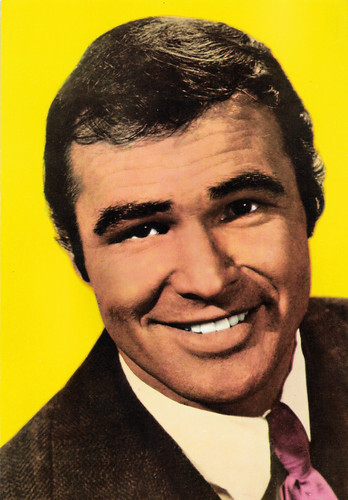
Spanish postcard by Bergas Industrias Gráficas, no. 1063. Photo: Vedettes Enr., Charlesbourg, Canada.
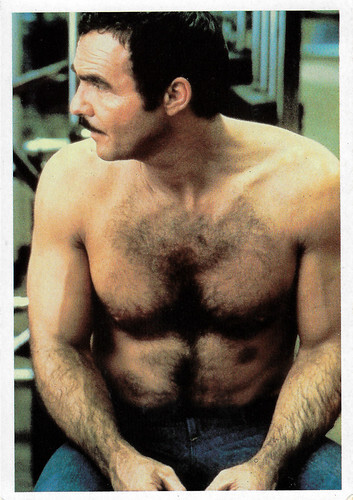
French postcard by Humour a la Carte, Paris, no. ST-149.
The image of the self-deprecating adventurer and modern outlaw
The late 1970s and early 1980s saw many successes for Burt Reynolds, especially as 'Bandit' in Smokey and the Bandit (Hal Needham, 1977) with Jerry Reed and Sally Field, Semi-Tough (Michael Ritchie, 1977), Hooper (Hal Needham, 1978), Smokey and the Bandit II (Hal Needham, 1980), The Cannonball Run (Hal Needham, 1981) with Roger Moore and Farrah Fawcett, Sharky's Machine (Burt Reynolds, 1981), The Best Little Whorehouse in Texas (Colin Higgins, 1982) with Dolly Parton, and Cannonball Run II (Hal Needham, 1984).
With these artistically rather undemanding action comedies, in which Reynolds cultivated the image of the self-deprecating adventurer and modern outlaw, Reynolds established himself as one of the most attractive and - with four to five million dollars per film - best-paid stars of his time. Reynolds was voted the world's number one box-office star for five consecutive years (1978–1982) in the annual Top Ten Money Making Stars Poll.
The moustachioed actor made a cameo appearance in Mel Brooks' silent comedy Silent Movie (1976), parodying himself as a vain superstar. However, his image became so entrenched that audiences did not accept him as a performer in more ambitious films such as the black comedy The End (Burt Reynolds, 1978) and the relationship comedy Starting Over (Alan J. Pakula, 1979) opposite Jill Clayburgh and Candice Bergen, which is why Reynolds mainly made sequels to his successful films.
For director Blake Edwards, Reynolds starred in The Man Who Loved Women (1983), a remake in English of François Truffaut 's 1977 film L'Homme qui aimait les femmes, but it also flopped. In 1984, he collaborated with another of Hollywood's biggest box office magnets of the 1970s and early 1980s: Clint Eastwood . For the action-comedy City Heat (Richard Benjamin, 1984), Eastwood received a record fee of five million US dollars and Reynolds had to make do with a fee of four million US dollars. During filming, he broke his jaw when instead of being hit with a breakable chair he was hit with a steel one which meant that he couldn't eat, lost a 1/4 of his body weight and became addicted to painkillers for 2 years.
His action comedies became less successful and his Hollywood career came to a standstill. Due to his age, Reynolds was no longer employable in his familiar role field. Younger stars such as Mel Gibson and Tom Cruise established themselves in the meantime. He became notorious for using a toupee or a combover to cover his receded frontal hairline. Unlike Clint Eastwood or Sean Connery , Reynolds also failed to make a name for himself in character roles that would have been appropriate for his age, which is why his films hardly found an audience after 1985.
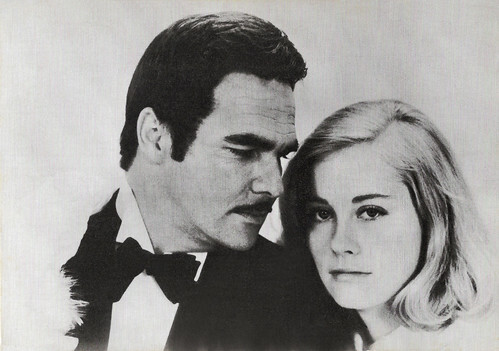
Portuguese postcard by Ediçao da Cinemateca Portuguesa. Burt Reynolds and Cybill Shepherd in At Long Last Love (Peter Bogdanovich, 1975).
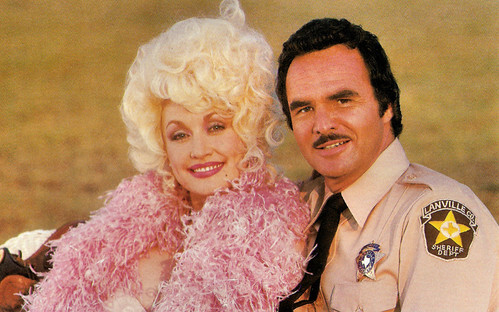
American postcard by Coral-Lee, Rancho Cordova, CA, in the Personality series, no. 115. Photo: Herb Ritts / Contact. Dolly Parton and Burt Reynolds in The Best Little Whorehouse in Texas (1982).
A mudslinging affair
Burt Reynolds starred with Kathleen Turner and Christopher Reeve in Switching Channels (Ted Kotcheff, 1989), a remake of the comedy The Front Page, it was a box-office disappointment. Even more poorly received was Physical Evidence (Michael Crichton, 1989) with Theresa Russell. Reynolds received excellent reviews for the caper comedy Breaking In (Bill Forsyth, 1989), but the commercial reception was poor.
Since the late 1980s, Reynolds starred mostly in B-rated film productions such as the buddy cop-comedy Cop and a Half (Henry Winkler, 1993). He had a cameo in The Player (Robert Altman, 1992), playing himself and complaining about people in Hollywood. He occasionally took supporting roles in more elaborate feature films, but they rarely received attention. Reynolds was more successful on television. During the first half of the 1990s, he was the star of the CBS series Evening Shade, for which he won an Emmy for lead actor in comedy and a Golden Globe in 1991. He also received a star on the Hollywood Walk of Fame during that period.
However, Reynolds had to file for bankruptcy in 1996; he was US$10 million in debt. Reynolds reportedly lost $20 million on bad business investments in some Florida restaurant chains. Happily, he made a comeback the same year with the film Striptease (Andrew Bergman, 1996) with Demi Moore . He could be seen in supporting parts in Citizen Ruth (1996), an early work from Alexander Payne, and Bean (Mel Smith, 1997) with Rowan Atkinson . A triumph was his portrayal of a charming porn film producer in Boogie Nights (Paul Thomas Anderson, 1997), which earned him an Oscar nomination for Best Supporting Actor and a Golden Globe. He emerged from bankruptcy in 1998. Despite his Oscar nomination for Boogie Nights and a new appreciation of his acting talent by movie critics, Reynolds failed to return to the A list. Reynolds was offered a role in Anderson's subsequent film, Magnolia (Paul Thomas Anderson, 1999), but he declined, saying that he hated working on Boogie Nights and hated Anderson.
Reynolds returned to directing with Hard Time (1998), an action TV film starring himself. From the mid-1960s Reynolds was also active as a director. In 1966 he directed an episode of the series Hawk, in which he also played the leading role himself. Reynolds made his feature directorial debut with Gator (1975), the sequel to White Lightning. Several feature films followed, including Sharky's Machine (1981) and Stick (1985). He then directed various television productions, including more than 30 episodes of Evening Shade (1990-1994). The feature film The Last Producer (2000) was his final production as a director. In 2000, he went on tour with his 'Burt Reynolds' One-Man Show'. In The Hollywood Sign (Sönke Wortmann, 2001), he played, with self-mockery, a jaded actor looking back nostalgically on his past achievements. Burt Reynolds was married to English actress Judy Carne from 1963 to 1965 and to actress Loni Anderson from 1988 to 1993. With Anderson, he adopted his son Quinton in 1988. He and Anderson separated after he fell in love with a cocktail waitress, Pam Seals. His divorce from Loni Anderson became a mudslinging affair and went through the media. He had other relationships with Dinah Shore (20 years his senior), singer Tammy Wynette, film star Sally Field and tennis star Chris Evert.
His autobiography 'My Life' was published in 1994 and a sequel, 'But Enough About Me', followed in 2005. Reynolds continued to play lead roles in forgettable films such as Cloud 9 (Harry Basil, 2006), Forget About It (BJ Davis, 2006), Deal (Gil Cates Jr., 2008), and A Bunch of Amateurs (Andy Cadiff, 2008). In 2011, Reynolds had to file for bankruptcy again after he was unable to pay the mortgage on his Florida home. He continued to act in films and took the lead in The Last Movie Star (Alan Rifkin, 2017) as an ageing movie star who was invited to a small, local film festival in Nashville. Many elements of the main character share similarities to Reynolds's personal life. Scenes from previous Reynolds films Deliverance (1972) and Smokey and the Bandit (1977) were included in the film. Referring to Reynolds's performance, a review in the Los Angeles Times stated, "Thanks to its star’s all-in commitment, the overtly maudlin film works better than it should." In May 2018, Reynolds joined the cast for Quentin Tarantino 's film Once Upon a Time in Hollywood as George Spahn, an eighty-year-old blind man who rented out his ranch to Charles Manson. Reynolds died before shooting his scenes and was later replaced by Bruce Dern. Burt Reynolds died of a heart attack in 2018 at the Jupiter Medical Center in Jupiter, Florida, at the age of 82. His ashes were interred at Hollywood Forever Cemetery.
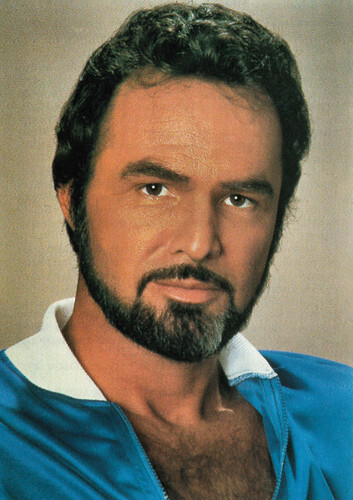
Dutch collectors card.
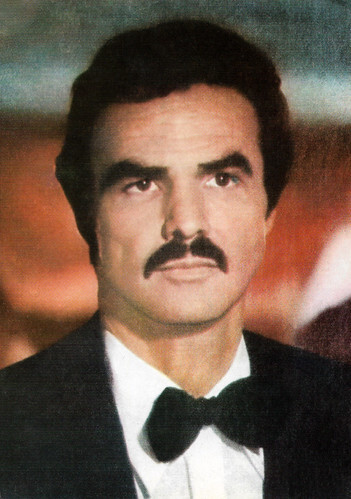
Romanian postcard by Casa Filmului Acin, no. C.P.C.S. Cda 43078.
Sources: Wikipedia (Dutch, German and English) and .

Spanish collectors card in the Telestars series by Ediciones Este, Barcelona, no. 198. Burt Reynolds in Hooper (Hal Needham, 1978).

American postcard by Coral-Lee, Rancho Cordova, CA, no. Personality # 81, SC176971063. Photo: Steve Schapiro / Sygma.
A canoe trip that turns into a nightmare
Burton Leon 'Burt' Reynolds was born in Lansing, Michigan, in 1936. His parents were Burton Milo Reynolds), and Harriette Fernette 'Fern' Reynolds née Miller. His paternal grandmother was Cherokee. After World War II, his family moved to Riviera Beach, Florida, where his father was chief of police. In his youth, Reynolds was an American football talent. After a serious injury, he switched to school drama and in 1956 he won the Florida State Drama Award. Reynolds won an acting scholarship to the Hyde Park Playhouse, a summer stock theatre, in Hyde Park, New York, and moved to New York.
He made his Broadway debut in the play 'Look, We've Come Through'. He gained a part in a revival of 'Mister Roberts', in which Charlton Heston played the starring role. Reynolds' first big break came when he was cast alongside Darren McGavin in the lead of the TV series Riverboat (1959), playing Ben Frazer. He quit Riverboat after only 20 episodes, claiming he did not get along with Darren McGavin and the executive producer, and that he had "a stupid part".
Reynolds made his feature film debut in the low-budget drama Angel Baby (Paul Wendkos, 1961) starring Salome Jens, George Hamilton and Mercedes McCambridge. From 1962 to 1965, he played "halfbreed" blacksmith Quint Aspen in the series Gunsmoke. He was cast in his first lead role in a film, the low-budget action film, Operation C.I.A. (Christian Nyby, 1965). Reynolds was given the title role in a TV series, Hawk (1966–1967), playing Native American detective John Hawk. It ran for 17 episodes before being cancelled. Reynolds appeared in numerous TV roles until the early 1970s.
Reynolds had leading roles in such films as the Spaghetti Western Navajo Joe (Sergio Corbucci, 1966), the Mexican-American action film Shark! (Samuel Fuller, 1969), the Western comedy Sam Whiskey (Arnold Laven, 1969) with Angie Dickinson , and the Western 100 Rifles (Tom Gries, 1969) with Jim Brown and Raquel Welch . His role as Lewis Medlock opposite Jon Voight in Deliverance (John Boorman, 1972) finally made Burt Reynolds a bonafide star. Boorman's gritty action drama, in which a group of adventurous city slickers go on a canoe trip that turns into a nightmare, became a classic and is generally considered Reynolds' best film. That year, a nude photo in Cosmopolitan also contributed greatly to his rapidly rising popularity. Reynolds lay casually on a bearskin and covered his more intimate body parts with his left arm. The photo is considered to be the first centrefold of a naked man, which became known worldwide and caused the number of his admirers to skyrocket. The issue sold 1.5 million copies. He later said that he deeply regretted posing for the photo, as he believed it lost him an Academy Award nomination for Deliverance (1972), as he would not be seen as a 'serious actor'.
Reynolds was considered for the role of James Bond. He turned down the role, believing that an American couldn't play the role. As a charming and quick-witted talk show guest on American television, Reynolds consolidated his fame and became a sex symbol and top star. He starred in a number of subsequent box office hits, such as Shamus (Buzz Kulik, 1973), White Lightning (Joseph Sargent, 1973) and The Longest Yard (Robert Aldrich, 1974). He also made a cameo in the Woody Allen film, Everything You Always Wanted to Know About Sex* (*But Were Afraid to Ask) (1972). Reynolds then appeared in two big-budget fiascos: the musical At Long Last Love (Peter Bogdanovich, 1975) with Cybill Shepherd, and Lucky Lady (Stanley Donen, 1975) with Gene Hackman and Liza Minnelli.

Spanish postcard by Bergas Industrias Gráficas, no. 1063. Photo: Vedettes Enr., Charlesbourg, Canada.

French postcard by Humour a la Carte, Paris, no. ST-149.
The image of the self-deprecating adventurer and modern outlaw
The late 1970s and early 1980s saw many successes for Burt Reynolds, especially as 'Bandit' in Smokey and the Bandit (Hal Needham, 1977) with Jerry Reed and Sally Field, Semi-Tough (Michael Ritchie, 1977), Hooper (Hal Needham, 1978), Smokey and the Bandit II (Hal Needham, 1980), The Cannonball Run (Hal Needham, 1981) with Roger Moore and Farrah Fawcett, Sharky's Machine (Burt Reynolds, 1981), The Best Little Whorehouse in Texas (Colin Higgins, 1982) with Dolly Parton, and Cannonball Run II (Hal Needham, 1984).
With these artistically rather undemanding action comedies, in which Reynolds cultivated the image of the self-deprecating adventurer and modern outlaw, Reynolds established himself as one of the most attractive and - with four to five million dollars per film - best-paid stars of his time. Reynolds was voted the world's number one box-office star for five consecutive years (1978–1982) in the annual Top Ten Money Making Stars Poll.
The moustachioed actor made a cameo appearance in Mel Brooks' silent comedy Silent Movie (1976), parodying himself as a vain superstar. However, his image became so entrenched that audiences did not accept him as a performer in more ambitious films such as the black comedy The End (Burt Reynolds, 1978) and the relationship comedy Starting Over (Alan J. Pakula, 1979) opposite Jill Clayburgh and Candice Bergen, which is why Reynolds mainly made sequels to his successful films.
For director Blake Edwards, Reynolds starred in The Man Who Loved Women (1983), a remake in English of François Truffaut 's 1977 film L'Homme qui aimait les femmes, but it also flopped. In 1984, he collaborated with another of Hollywood's biggest box office magnets of the 1970s and early 1980s: Clint Eastwood . For the action-comedy City Heat (Richard Benjamin, 1984), Eastwood received a record fee of five million US dollars and Reynolds had to make do with a fee of four million US dollars. During filming, he broke his jaw when instead of being hit with a breakable chair he was hit with a steel one which meant that he couldn't eat, lost a 1/4 of his body weight and became addicted to painkillers for 2 years.
His action comedies became less successful and his Hollywood career came to a standstill. Due to his age, Reynolds was no longer employable in his familiar role field. Younger stars such as Mel Gibson and Tom Cruise established themselves in the meantime. He became notorious for using a toupee or a combover to cover his receded frontal hairline. Unlike Clint Eastwood or Sean Connery , Reynolds also failed to make a name for himself in character roles that would have been appropriate for his age, which is why his films hardly found an audience after 1985.

Portuguese postcard by Ediçao da Cinemateca Portuguesa. Burt Reynolds and Cybill Shepherd in At Long Last Love (Peter Bogdanovich, 1975).

American postcard by Coral-Lee, Rancho Cordova, CA, in the Personality series, no. 115. Photo: Herb Ritts / Contact. Dolly Parton and Burt Reynolds in The Best Little Whorehouse in Texas (1982).
A mudslinging affair
Burt Reynolds starred with Kathleen Turner and Christopher Reeve in Switching Channels (Ted Kotcheff, 1989), a remake of the comedy The Front Page, it was a box-office disappointment. Even more poorly received was Physical Evidence (Michael Crichton, 1989) with Theresa Russell. Reynolds received excellent reviews for the caper comedy Breaking In (Bill Forsyth, 1989), but the commercial reception was poor.
Since the late 1980s, Reynolds starred mostly in B-rated film productions such as the buddy cop-comedy Cop and a Half (Henry Winkler, 1993). He had a cameo in The Player (Robert Altman, 1992), playing himself and complaining about people in Hollywood. He occasionally took supporting roles in more elaborate feature films, but they rarely received attention. Reynolds was more successful on television. During the first half of the 1990s, he was the star of the CBS series Evening Shade, for which he won an Emmy for lead actor in comedy and a Golden Globe in 1991. He also received a star on the Hollywood Walk of Fame during that period.
However, Reynolds had to file for bankruptcy in 1996; he was US$10 million in debt. Reynolds reportedly lost $20 million on bad business investments in some Florida restaurant chains. Happily, he made a comeback the same year with the film Striptease (Andrew Bergman, 1996) with Demi Moore . He could be seen in supporting parts in Citizen Ruth (1996), an early work from Alexander Payne, and Bean (Mel Smith, 1997) with Rowan Atkinson . A triumph was his portrayal of a charming porn film producer in Boogie Nights (Paul Thomas Anderson, 1997), which earned him an Oscar nomination for Best Supporting Actor and a Golden Globe. He emerged from bankruptcy in 1998. Despite his Oscar nomination for Boogie Nights and a new appreciation of his acting talent by movie critics, Reynolds failed to return to the A list. Reynolds was offered a role in Anderson's subsequent film, Magnolia (Paul Thomas Anderson, 1999), but he declined, saying that he hated working on Boogie Nights and hated Anderson.
Reynolds returned to directing with Hard Time (1998), an action TV film starring himself. From the mid-1960s Reynolds was also active as a director. In 1966 he directed an episode of the series Hawk, in which he also played the leading role himself. Reynolds made his feature directorial debut with Gator (1975), the sequel to White Lightning. Several feature films followed, including Sharky's Machine (1981) and Stick (1985). He then directed various television productions, including more than 30 episodes of Evening Shade (1990-1994). The feature film The Last Producer (2000) was his final production as a director. In 2000, he went on tour with his 'Burt Reynolds' One-Man Show'. In The Hollywood Sign (Sönke Wortmann, 2001), he played, with self-mockery, a jaded actor looking back nostalgically on his past achievements. Burt Reynolds was married to English actress Judy Carne from 1963 to 1965 and to actress Loni Anderson from 1988 to 1993. With Anderson, he adopted his son Quinton in 1988. He and Anderson separated after he fell in love with a cocktail waitress, Pam Seals. His divorce from Loni Anderson became a mudslinging affair and went through the media. He had other relationships with Dinah Shore (20 years his senior), singer Tammy Wynette, film star Sally Field and tennis star Chris Evert.
His autobiography 'My Life' was published in 1994 and a sequel, 'But Enough About Me', followed in 2005. Reynolds continued to play lead roles in forgettable films such as Cloud 9 (Harry Basil, 2006), Forget About It (BJ Davis, 2006), Deal (Gil Cates Jr., 2008), and A Bunch of Amateurs (Andy Cadiff, 2008). In 2011, Reynolds had to file for bankruptcy again after he was unable to pay the mortgage on his Florida home. He continued to act in films and took the lead in The Last Movie Star (Alan Rifkin, 2017) as an ageing movie star who was invited to a small, local film festival in Nashville. Many elements of the main character share similarities to Reynolds's personal life. Scenes from previous Reynolds films Deliverance (1972) and Smokey and the Bandit (1977) were included in the film. Referring to Reynolds's performance, a review in the Los Angeles Times stated, "Thanks to its star’s all-in commitment, the overtly maudlin film works better than it should." In May 2018, Reynolds joined the cast for Quentin Tarantino 's film Once Upon a Time in Hollywood as George Spahn, an eighty-year-old blind man who rented out his ranch to Charles Manson. Reynolds died before shooting his scenes and was later replaced by Bruce Dern. Burt Reynolds died of a heart attack in 2018 at the Jupiter Medical Center in Jupiter, Florida, at the age of 82. His ashes were interred at Hollywood Forever Cemetery.

Dutch collectors card.

Romanian postcard by Casa Filmului Acin, no. C.P.C.S. Cda 43078.
Sources: Wikipedia (Dutch, German and English) and .
Published on November 02, 2023 23:00
November 1, 2023
Liberace
American entertainer Liberace (1919-1987) is most remembered for his extravagant costumes and trademark candelabra placed on the lids of his Baldwin piano decorated with small mirrors. Liberace was loved by his audiences for his virtuoso talent on the piano and unique showmanship. While wildly successful and good-natured outwardly, Liberace was a complicated man whose political, social and religious conservatism existed side-by-side with a lifetime of secretive homosexuality.
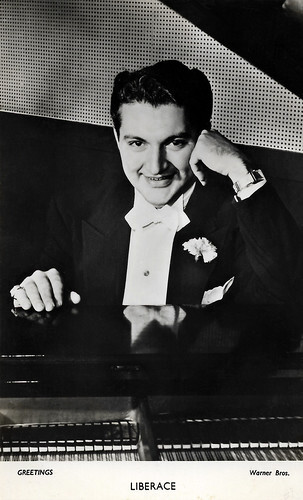
British postcard in the Greetings series. Photo: Warner Bros.
A honky tonk pianist on a South Sea island
Liberace was born as Wladziu Valentino Liberace in 1919, into a musical family, in West Allis, Wisconsin. His mother, Frances Liberace (née Zuchowski), whose parents were Polish, played the piano. His father, Salvatore Liberace, an immigrant from Formia, Italy, played the French horn for the Milwaukee Symphony. His siblings, George Liberace, Angie Liberace and Rudy Liberace, also had musical abilities.
Liberace's own extraordinary natural talent became evident when he learned to play the piano, by ear, at the age of four. Although Salvatore tried to discourage his son's interest in the piano, praises from Ignacy Jan Paderewski, a famous Polish pianist, helped the young musician follow his musical career. As a teenager, Liberace earned wages playing popular tunes at movie theatres and speakeasies.
Despite being proud of his son's accomplishments, Salvatore strictly opposed Liberace's preference for popular music over the classics. Pianist Florence Bettray Kelly took control of Liberace's classical training when he was 14. He debuted as a soloist with the Chicago Symphony, under the direction of Dr. Frederick Stock. At age 17, Liberace joined the Works Progress Administration Symphony Orchestra.
He received a scholarship to attend the Wisconsin College of Music. In 1939, after a classical recital, Liberace's audience requested the popular tune, 'Three Little Fishes'. Liberace seized the opportunity and performed the tune with a semi-classical style which the audience loved. Soon, this unique style of playing the piano got Liberace bookings in large nightclubs.
By 1940, Liberace was travelling with his custom-made piano, on top of which he would place his candelabrum. He then took Paderewski's advice and dropped Wladziu and Valentino to become simply Liberace. He made his film debut in South Sea Sinner (H. Bruce Humberstone, 1950), with Macdonald Carey and Shelley Winters . Liberace played a honky tonk pianist on a South Sea island.
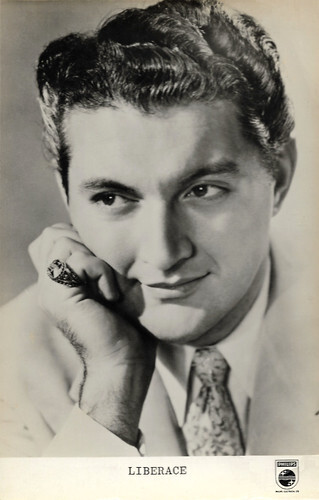
Vintage promotion card. Photo: Philips.
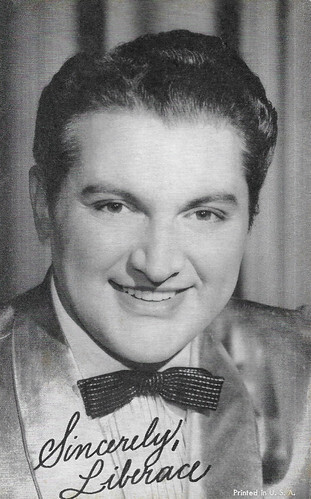
American Arcade card.
Flamboyant costumes and expensive ornaments
The Liberace Show (1952), a syndicated television program, turned Liberace into a musical symbol. It began as a summertime replacement for The Dinah Shore Show (1951), but after two years, the show was one of the most popular on TV. 217 American stations carried the show and it could be seen in 20 foreign countries. Sold-out live appearances at Madison Square Garden enhanced the pianist's popularity even more.
When he opened Las Vegas' Riviera Casino-Hotel in 1954, he was the city's highest-paid entertainer. That concert was the first one where he wore extravagant costumes - in this case, a gold lame jacket. Liberace added flamboyant costumes and expensive ornaments to his already unique performances. His second film was Sincerely Yours (Gordon Douglas, 1955) with Joanne Dru and Dorothy Malone.
The episodes of the television series Batman (1966) on which he guest-starred as Chandel/Harry, The Devil's Fingers (1966) and The Dead Ringers (1966), were the highest-rated in the series' history. In 1972, Liberace wrote his best-selling autobiography, 'Liberace', in 1972. His first book, 'Liberace Cooks', went into seven printings. In 1977, Liberace founded the non-profit Liberace Foundation for the Performing and Creative Arts. The year 1978 brought the opening of The Liberace Museum in Las Vegas, Nevada, which serves as key funding for the Liberace Foundation. The profits from the museum provide scholarship money for financially needy college musicians.
Liberace continued performing until the fall of 1986, despite suffering from heart disease and emphysema during most of the 1980s. A closeted homosexual his entire life, Liberace was secretly diagnosed with AIDS sometime in August 1985, which he also kept secret from the public until the day he died. His last concert was at Radio City Music Hall in 1986. He died in his Palm Springs home in 1987, at age 67. Liberace was bestowed with many awards during his lifetime including Instrumentalist of the Year, Best Dressed Entertainer, Entertainer of the Year, two Emmy Awards, six gold albums, and two stars on the Hollywood Walk of Fame.
In 'The Guinness Book of World Records', he has been listed as the world's highest-paid musician and pianist. Liberace was an extremely talented and versatile man. He not only played the piano but sang, danced and joked during his performances. In fact, one of Liberace's biggest accomplishments was his ability to turn a recital into a show full of music, glitter and personality. In the cinema, he was portrayed by Victor Garber in Liberace: Behind the Music (David Greene, 1988), Andrew Robinson in Liberace (William Hale, Tommy Groszman, 1988) and Michael Douglas in Behind the Candelabra (Steven Soderbergh, 2013). Many of his pianos, cars, jewellery and costumes are now on display in the Liberace Museum in Las Vegas.
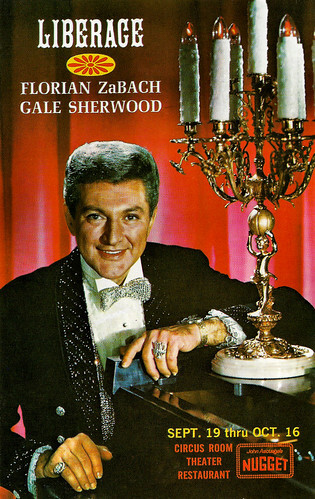
American promotion card for Nugget by Mike Roberts Color Productions, Berkeley, California, no. SC11815.
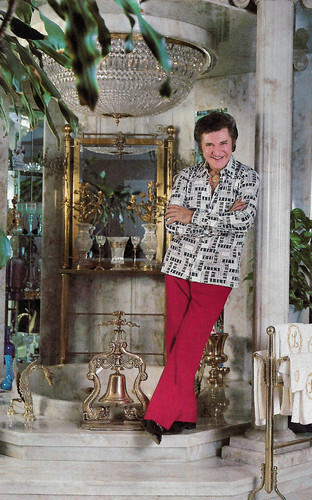
American postcard by Coral-Lee, Rancho Cordova, CA, # 100. Photo: Annie Leibovitz / Contact, 1981.
Sources: (IMDb), Wikipedia and .

British postcard in the Greetings series. Photo: Warner Bros.
A honky tonk pianist on a South Sea island
Liberace was born as Wladziu Valentino Liberace in 1919, into a musical family, in West Allis, Wisconsin. His mother, Frances Liberace (née Zuchowski), whose parents were Polish, played the piano. His father, Salvatore Liberace, an immigrant from Formia, Italy, played the French horn for the Milwaukee Symphony. His siblings, George Liberace, Angie Liberace and Rudy Liberace, also had musical abilities.
Liberace's own extraordinary natural talent became evident when he learned to play the piano, by ear, at the age of four. Although Salvatore tried to discourage his son's interest in the piano, praises from Ignacy Jan Paderewski, a famous Polish pianist, helped the young musician follow his musical career. As a teenager, Liberace earned wages playing popular tunes at movie theatres and speakeasies.
Despite being proud of his son's accomplishments, Salvatore strictly opposed Liberace's preference for popular music over the classics. Pianist Florence Bettray Kelly took control of Liberace's classical training when he was 14. He debuted as a soloist with the Chicago Symphony, under the direction of Dr. Frederick Stock. At age 17, Liberace joined the Works Progress Administration Symphony Orchestra.
He received a scholarship to attend the Wisconsin College of Music. In 1939, after a classical recital, Liberace's audience requested the popular tune, 'Three Little Fishes'. Liberace seized the opportunity and performed the tune with a semi-classical style which the audience loved. Soon, this unique style of playing the piano got Liberace bookings in large nightclubs.
By 1940, Liberace was travelling with his custom-made piano, on top of which he would place his candelabrum. He then took Paderewski's advice and dropped Wladziu and Valentino to become simply Liberace. He made his film debut in South Sea Sinner (H. Bruce Humberstone, 1950), with Macdonald Carey and Shelley Winters . Liberace played a honky tonk pianist on a South Sea island.

Vintage promotion card. Photo: Philips.

American Arcade card.
Flamboyant costumes and expensive ornaments
The Liberace Show (1952), a syndicated television program, turned Liberace into a musical symbol. It began as a summertime replacement for The Dinah Shore Show (1951), but after two years, the show was one of the most popular on TV. 217 American stations carried the show and it could be seen in 20 foreign countries. Sold-out live appearances at Madison Square Garden enhanced the pianist's popularity even more.
When he opened Las Vegas' Riviera Casino-Hotel in 1954, he was the city's highest-paid entertainer. That concert was the first one where he wore extravagant costumes - in this case, a gold lame jacket. Liberace added flamboyant costumes and expensive ornaments to his already unique performances. His second film was Sincerely Yours (Gordon Douglas, 1955) with Joanne Dru and Dorothy Malone.
The episodes of the television series Batman (1966) on which he guest-starred as Chandel/Harry, The Devil's Fingers (1966) and The Dead Ringers (1966), were the highest-rated in the series' history. In 1972, Liberace wrote his best-selling autobiography, 'Liberace', in 1972. His first book, 'Liberace Cooks', went into seven printings. In 1977, Liberace founded the non-profit Liberace Foundation for the Performing and Creative Arts. The year 1978 brought the opening of The Liberace Museum in Las Vegas, Nevada, which serves as key funding for the Liberace Foundation. The profits from the museum provide scholarship money for financially needy college musicians.
Liberace continued performing until the fall of 1986, despite suffering from heart disease and emphysema during most of the 1980s. A closeted homosexual his entire life, Liberace was secretly diagnosed with AIDS sometime in August 1985, which he also kept secret from the public until the day he died. His last concert was at Radio City Music Hall in 1986. He died in his Palm Springs home in 1987, at age 67. Liberace was bestowed with many awards during his lifetime including Instrumentalist of the Year, Best Dressed Entertainer, Entertainer of the Year, two Emmy Awards, six gold albums, and two stars on the Hollywood Walk of Fame.
In 'The Guinness Book of World Records', he has been listed as the world's highest-paid musician and pianist. Liberace was an extremely talented and versatile man. He not only played the piano but sang, danced and joked during his performances. In fact, one of Liberace's biggest accomplishments was his ability to turn a recital into a show full of music, glitter and personality. In the cinema, he was portrayed by Victor Garber in Liberace: Behind the Music (David Greene, 1988), Andrew Robinson in Liberace (William Hale, Tommy Groszman, 1988) and Michael Douglas in Behind the Candelabra (Steven Soderbergh, 2013). Many of his pianos, cars, jewellery and costumes are now on display in the Liberace Museum in Las Vegas.

American promotion card for Nugget by Mike Roberts Color Productions, Berkeley, California, no. SC11815.

American postcard by Coral-Lee, Rancho Cordova, CA, # 100. Photo: Annie Leibovitz / Contact, 1981.
Sources: (IMDb), Wikipedia and .
Published on November 01, 2023 23:00
October 31, 2023
Troy (2004)
Troy (2004) is a very expensive American film epic about the Trojan War, based on Homer's 'Iliad' and 'Odyssey'. The film follows the assault on Troy by the united Greek forces and chronicles the fates of the men involved. The Trojan War took place around 1200 BC on the west coast of present-day Turkey. Troy was directed by Wolfgang Petersen and produced by Warner Bros. The film received a nomination for best costumes at the Academy Awards.
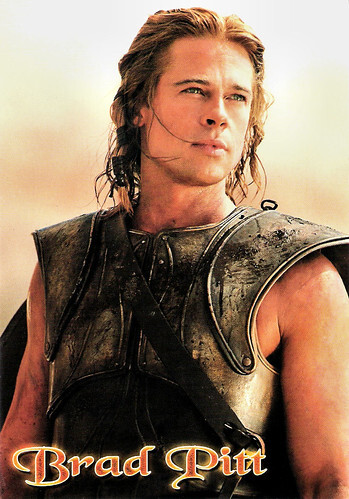
Italian postcard by EdiBas S.r.l., Torino, no. Pc 1.338. Photo: Grazia Neri. Brad Pitt in Troy (Wolfgang Petersen, 2004).
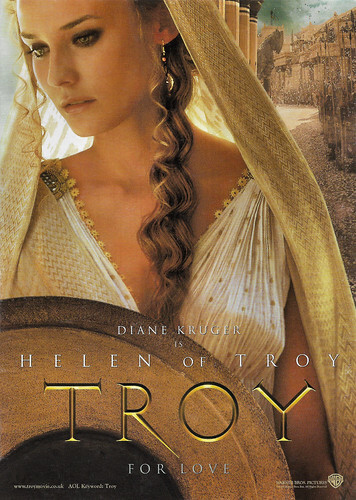
British postcard. Photo: Warner Bros. Diane Kruger as Helen of Troy in Troy (Wolfgang Petersen, 2004).
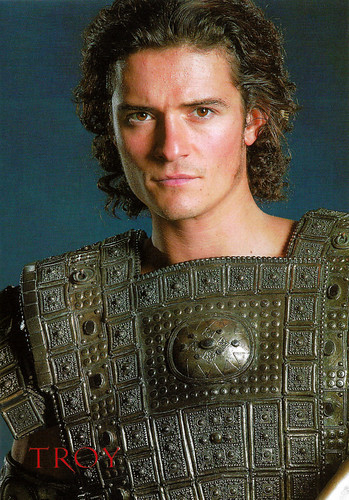
British postcard in the Cinemascope Collections, no. 617. Orlando Bloom in Troy (Wolfgang Petersen, 2004).
The decade-long Trojan War condensed in a few weeks
The script for Troy (Wolfgang Petersen, 2004) was written by David Benioff. It is loosely based on Homer's 'Iliad' in its narration of the entire story of the decade-long Trojan War — condensed into little more than a couple of weeks.
In the year 1193 BC, Agamemnon, king of Mycenae (Brian Cox), dominates most of the Greek world. Then, during a peace mission, the Trojan prince Paris ( Orlando Bloom ) lures Helena (Diane Kruger), the most beautiful woman in Greece, away from her husband, King Menelaus (Brendan Gleeson) of Sparta.
Menelaus is compromised in his honour and convinces his brother Agamemnon to take part in an attack on Troy. Agamemnon sees in the attack his chance to expand his power even further. Backed by thousands of Greek kings and warriors, they set off with 1,000 ships holding 50,000 Greeks to Troy.
The warriors include Ajax (Tyler Mane), Odysseus (Sean Bean) and Achilles ( Brad Pitt ) with his Myrmidons. For a long time, the battle between the Greeks and Trojans dragged on, with many deaths on both sides. It is only with the construction of the Trojan Horse that an end is forced to the bloody war.
The film's total production costs came to $175,000,000, making Troy one of the most expensive films ever if not adjusted for inflation. Worldwide, the film brought in a total of $497,409,852. Troy was received with mixed reactions by viewers and critics. Roger Ebert gave the film 2 stars, expressing disappointment in the film since it deviates so much from the original mythology.
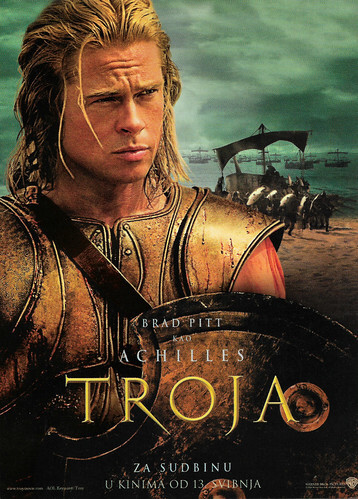
Serbian promotion card. Photo: Warner Bros. Brad Pitt as Achilles in Troy (Wolfgang Petersen, 2004).
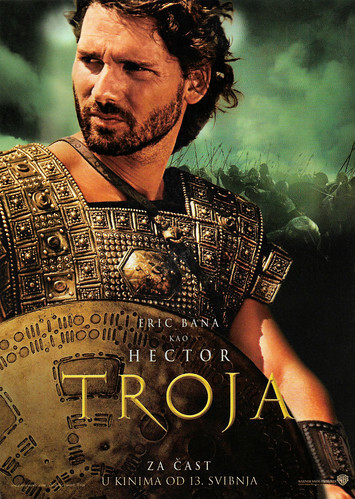
Serbian promotion card. Photo: Warner Bros. Eric Bana as Hector in Troy (Wolfgang Petersen, 2004).
The role of the gods is greatly reduced
The large sets for Troy were built at Fort Ricasoli in Malta. Shooting took place here from April to June 2003. Other major filming locations were Mellieħa and Comino. Scenes at the outer walls of Troy were shot in Cabo San Lucas.
To keep the story of Troy from becoming too complex, the film narrative deviates from Homer's works on the Trojan War in certain ways. First, in the film, the Trojan War lasts much shorter than Homer's: a few weeks instead of ten years. In addition, some important characters, including Diomedes, Calchas, Laocoön, Palamedes and Cassandra, are missing from the film. Furthermore, certain characters meet their end differently in the film than in Homer's stories.
The role of the gods is also greatly reduced in the film. In Homer's works, especially Zeus, Hera, Pallas Athene, Ares and Apollo take an active part in the war, unlike in the film. In the film, Agamemnon is the commander of all the Greek armies and was convinced by his brother to go to war. In Homer's works, almost all the kings of Greece were suitors of Helen of Sparta. When she chose her husband, Odysseus made all these men take an oath to protect her chosen marriage. When Helena was taken away from Menelaus, he made all the former suitors honour their oaths by travelling with him to Troy.
Since Agamemnon had the largest army, he was the commander-in-chief. In the film, the duel between Paris and Menelaus is not decisive, or in other words, the outcome of the battle did not mean the decision of the war. In the 'Iliad', the duel takes place in the tenth year of the war, when everyone is longing for the end. The duel was to bring the decision. Paris lost the duel to Menelaus, but was saved just in time by the goddess Aphrodite and thus managed to escape death. Apollo, however, had a Trojan throw a spear at the Greeks, breaking the treaty and allowing the war to resume in full force. In the film, Menelaus also wins the duel, but Hektor intervenes to protect his brother, killing Menelaus in the process.
Roger Ebert gave a thumbs up in his review but also wrote: "By treating Achilles and the other characters as if they were human, instead of the larger-than-life creations of Greek myth, director Wolfgang Petersen miscalculates. What happens in Greek myth cannot happen between psychologically plausible characters. That's the whole point of myth."

Serbian promotion card. Photo: Warner Bros. Orlando Bloom as Paris in Troy (Wolfgang Petersen, 2004).
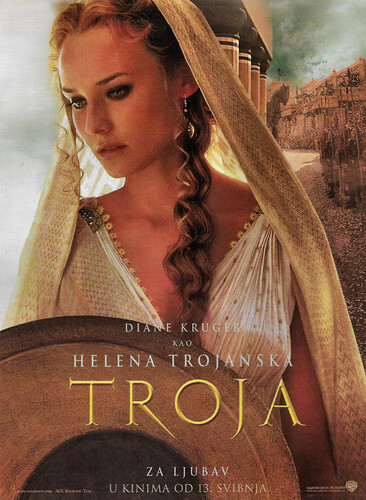
Serbian promotion card. Photo: Warner Bros. Diane Kruger as Helen of Troy in Troy (Wolfgang Petersen, 2004).
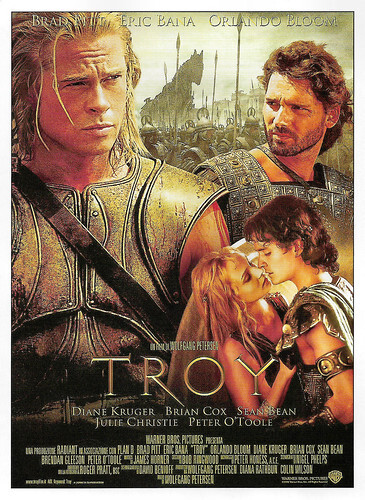
French collectors card. French film poster by Warner Bros. Brad Pitt , Diane Kruger, Orlando Bloom and Eric Bana in Troy (Wolfgang Petersen, 2004).
Sources: Roger Ebert (Roger Ebert.com), Wikipedia (Dutch) and IMDb.

Italian postcard by EdiBas S.r.l., Torino, no. Pc 1.338. Photo: Grazia Neri. Brad Pitt in Troy (Wolfgang Petersen, 2004).

British postcard. Photo: Warner Bros. Diane Kruger as Helen of Troy in Troy (Wolfgang Petersen, 2004).

British postcard in the Cinemascope Collections, no. 617. Orlando Bloom in Troy (Wolfgang Petersen, 2004).
The decade-long Trojan War condensed in a few weeks
The script for Troy (Wolfgang Petersen, 2004) was written by David Benioff. It is loosely based on Homer's 'Iliad' in its narration of the entire story of the decade-long Trojan War — condensed into little more than a couple of weeks.
In the year 1193 BC, Agamemnon, king of Mycenae (Brian Cox), dominates most of the Greek world. Then, during a peace mission, the Trojan prince Paris ( Orlando Bloom ) lures Helena (Diane Kruger), the most beautiful woman in Greece, away from her husband, King Menelaus (Brendan Gleeson) of Sparta.
Menelaus is compromised in his honour and convinces his brother Agamemnon to take part in an attack on Troy. Agamemnon sees in the attack his chance to expand his power even further. Backed by thousands of Greek kings and warriors, they set off with 1,000 ships holding 50,000 Greeks to Troy.
The warriors include Ajax (Tyler Mane), Odysseus (Sean Bean) and Achilles ( Brad Pitt ) with his Myrmidons. For a long time, the battle between the Greeks and Trojans dragged on, with many deaths on both sides. It is only with the construction of the Trojan Horse that an end is forced to the bloody war.
The film's total production costs came to $175,000,000, making Troy one of the most expensive films ever if not adjusted for inflation. Worldwide, the film brought in a total of $497,409,852. Troy was received with mixed reactions by viewers and critics. Roger Ebert gave the film 2 stars, expressing disappointment in the film since it deviates so much from the original mythology.

Serbian promotion card. Photo: Warner Bros. Brad Pitt as Achilles in Troy (Wolfgang Petersen, 2004).

Serbian promotion card. Photo: Warner Bros. Eric Bana as Hector in Troy (Wolfgang Petersen, 2004).
The role of the gods is greatly reduced
The large sets for Troy were built at Fort Ricasoli in Malta. Shooting took place here from April to June 2003. Other major filming locations were Mellieħa and Comino. Scenes at the outer walls of Troy were shot in Cabo San Lucas.
To keep the story of Troy from becoming too complex, the film narrative deviates from Homer's works on the Trojan War in certain ways. First, in the film, the Trojan War lasts much shorter than Homer's: a few weeks instead of ten years. In addition, some important characters, including Diomedes, Calchas, Laocoön, Palamedes and Cassandra, are missing from the film. Furthermore, certain characters meet their end differently in the film than in Homer's stories.
The role of the gods is also greatly reduced in the film. In Homer's works, especially Zeus, Hera, Pallas Athene, Ares and Apollo take an active part in the war, unlike in the film. In the film, Agamemnon is the commander of all the Greek armies and was convinced by his brother to go to war. In Homer's works, almost all the kings of Greece were suitors of Helen of Sparta. When she chose her husband, Odysseus made all these men take an oath to protect her chosen marriage. When Helena was taken away from Menelaus, he made all the former suitors honour their oaths by travelling with him to Troy.
Since Agamemnon had the largest army, he was the commander-in-chief. In the film, the duel between Paris and Menelaus is not decisive, or in other words, the outcome of the battle did not mean the decision of the war. In the 'Iliad', the duel takes place in the tenth year of the war, when everyone is longing for the end. The duel was to bring the decision. Paris lost the duel to Menelaus, but was saved just in time by the goddess Aphrodite and thus managed to escape death. Apollo, however, had a Trojan throw a spear at the Greeks, breaking the treaty and allowing the war to resume in full force. In the film, Menelaus also wins the duel, but Hektor intervenes to protect his brother, killing Menelaus in the process.
Roger Ebert gave a thumbs up in his review but also wrote: "By treating Achilles and the other characters as if they were human, instead of the larger-than-life creations of Greek myth, director Wolfgang Petersen miscalculates. What happens in Greek myth cannot happen between psychologically plausible characters. That's the whole point of myth."

Serbian promotion card. Photo: Warner Bros. Orlando Bloom as Paris in Troy (Wolfgang Petersen, 2004).

Serbian promotion card. Photo: Warner Bros. Diane Kruger as Helen of Troy in Troy (Wolfgang Petersen, 2004).

French collectors card. French film poster by Warner Bros. Brad Pitt , Diane Kruger, Orlando Bloom and Eric Bana in Troy (Wolfgang Petersen, 2004).
Sources: Roger Ebert (Roger Ebert.com), Wikipedia (Dutch) and IMDb.
Published on October 31, 2023 23:00
October 30, 2023
La Collectionneuse: Grace Moore
Nothing really predestined Grace Moore to become an opera diva and a movie star, as she was born in rural Tennessee in a conservative and religious family. But, by a combination of ambition, perseverance, fierce drive and hard work, she achieved her goal. She first found fame in Broadway musicals and then became a prima donna at the prestigious Metropolitan Opera. After an unsuccessful turn at MGM in 1930, she finally made it in Hollywood in 1934 at Columbia and helped to make movie audiences love opera.

German postcard by Ross Verlag, no. 6242/1, 1931-1932. Photo: Metro-Goldwyn-Mayer. Grace Moore in A Lady’s Morals (Sidney Franklin, 1930).
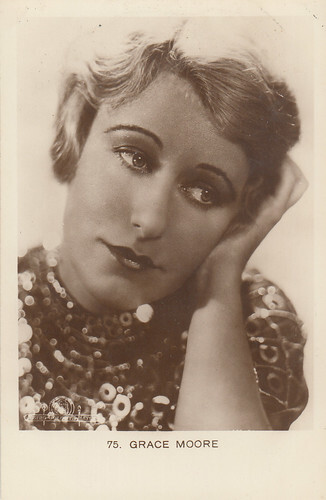
Belgian postcard by P.I.A. Belgaphot, Bruxelles, no. 75. Photo: MGM.
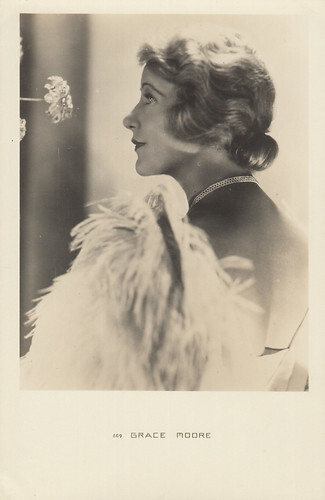
Dutch postcard, no. 669.
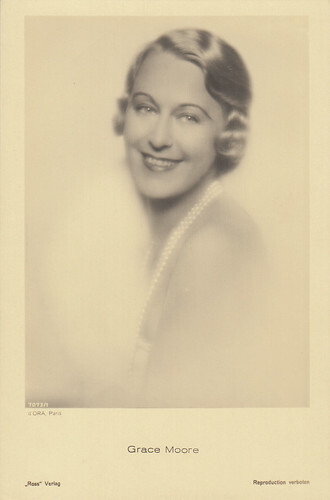
German postcard by Ross Verlag, no. 7073/1, 1931-1932. Photo: d'Ora, Paris.
From Slabtown to the Metropolitan Opera
Grace Moore was born Mary Willie Grace Moore on the 5th of December 1898 in Slabtown, Tennessee, U.S.A.
At the end of the 10’s, she got voice training at the Wilson-Greene School of Music in Washington and, in 1919, she went to New York to start a stage career. In 1920, she appeared for the first time on Broadway in the musical 'Hitchy-Koo'.
She soon went to Paris, where she continued her musical training. When she got short of funds, she came back to the U.S.A. and successfully appeared on Broadway in 'The Music Box Revue' of 1923 (1923-1924) and 'The Music Box Revue of 1924' (1924-1925).
As her goal was to become an opera singer, she returned to Europe in 1925 for further classical study. After having been thoroughly prepared musically and linguistically for an operatic career, she made an impression on Giulio Gatti-Casazza, the Director of the Metropolitan Opera of New York, who signed her in mid-1927.
So, she went back to her native country and made her debut at the prestigious Metropolitan as Mimi in 'La Boheme' in February 1928. That same year, she played the same role at the Opera-Comique in Paris. In 1935, she would achieve great success by playing Mimi again at Covent Garden in London.
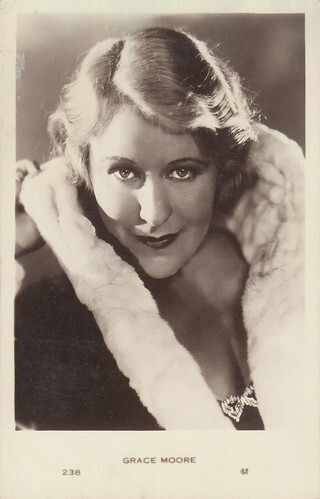
Spanish postcard by M.C. Barcelona, no. 238.
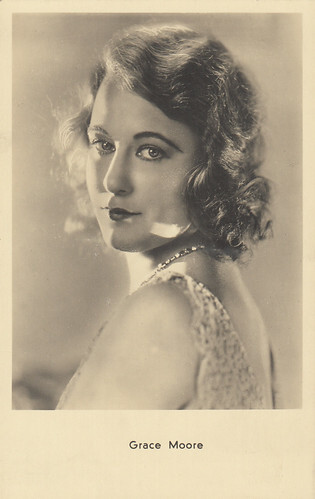
Austrian postcard by Iris Verlag, no. 6784.
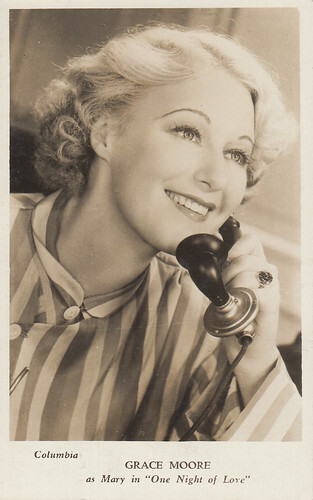
British postcard. Photo: Columbia. Grace Moore in One Night of Love (Victor Schertzinger, 1934).
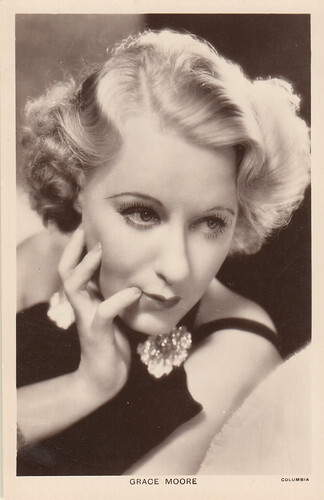
British postcard in the Picturegoer Series, no. 890. Photo: Columbia.
Hollywood
Under contract to M.G.M., Grace Moore made her screen debut in A Lady’s Morals (1930) and was also featured in its French-language version, Jenny Lind (1931). She co-starred with Metropolitan tenor Lawrence Tibbett in New Moon (1930).
Unfortunately, A Lady’s Morals and New Moon didn’t fare especially well at the box office and M.G.M. dropped her. She had to wait a few years more until Hollywood beckoned again.
It happened when Harry Cohn, head of Columbia, noticed her on Broadway in the operetta 'The Dubarry' (1932-1933) and signed her. Her first film at Columbia, One Night of Love (1934), was a smash hit and eventually made her a full-fledged movie star. This movie gave movie audiences the opportunity to hear her sing several arias from famous operas such as 'Carmen', 'La Traviata' or 'Madame Butterfly'.It was followed by another success, Love Me Forever (1935).
In 1935, she was awarded a medal by the Society of Arts and Science for her achievement in raising the standard of cinema entertainment. Suddenly, opera became all the rage in Hollywood. Paramount signed Gladys Swarthout and R.K.O. signed Lily Pons. Even Poverty Row’s Republic Studios wanted their own diva and hired Marion Talley, who had been in 1926 the youngest prima donna to sing at the Metropolitan Opera at that time. None of them achieved the same success onscreen.
Grace Moore then played Elizabeth "Sissi" of Austria in The King Steps Out (1936), the only musical Josef von Sternberg ever directed. Her stay at Columbia ended with When You’re in Love (1937) and I’ll Take Romance (1937). In addition to her movie career, she also increased her popularity by performing on the radio.
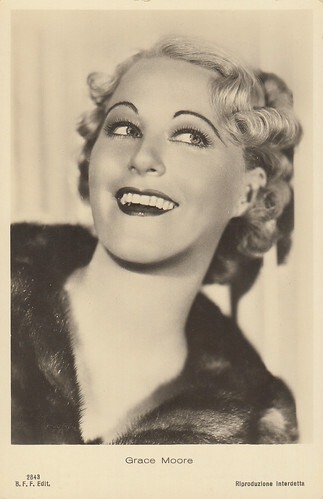
Italian postcard by Ballerini & Fratini, Firenze, no. 2843.
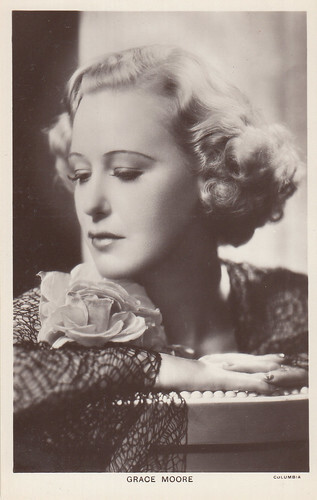
British postcard by Picturegoer, no. 890a. Photo: Columbia.
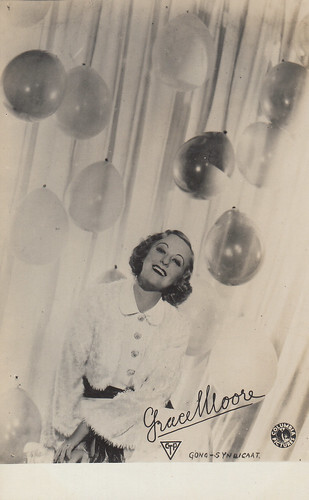
Postcard from the Dutch East Indies (now Indonesia) by CTP. Photo: Columbia Pictures.
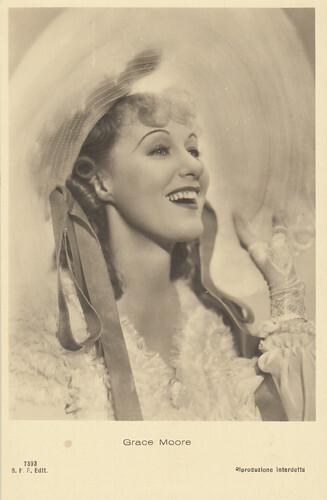
Italian postcard by B.F.F. Edit., no. 7393.
Louise
Grace Moore made her last screen appearance in Louise (1939), directed in France by Abel Gance and adapted from Gustave Charpentier’s opera.
At first, Charpentier, who was a cinema lover, was enthusiastic about the project. But, gradually, he became annoyed that many of his suggestions were not taken into consideration and became appalled by the changes which were being made to his opera.
In an interview in November 1938, he deplored the addition of several "vulgar and coarse scenes" to his work.
In a letter sent to Abel Gance the same month, he complained about the scenes that had been filmed by the director "notwithstanding his formal veto".
In the end, he was deeply disappointed by the movie and called it a "forgery" and a "shameful conspiracy" in a letter to Grace Moore in July 1939.
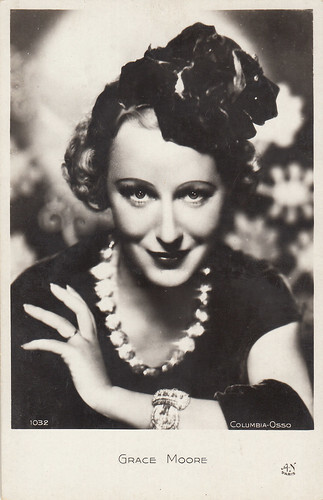
French postcard by A.N., Paris, no. 1032. Photo: Columbia - Osso.
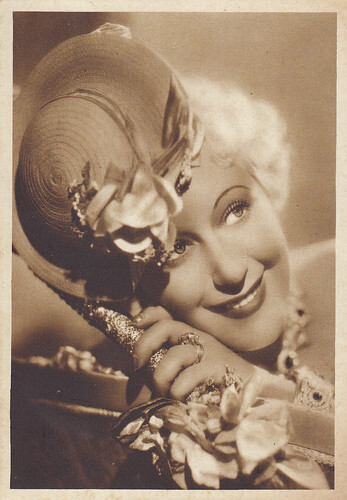
Italian postcard by Vecchioni & Guadagno, Roma. Grace Moore in When You’re in Love (Robert Riskin, Harry Lachman, 1937).
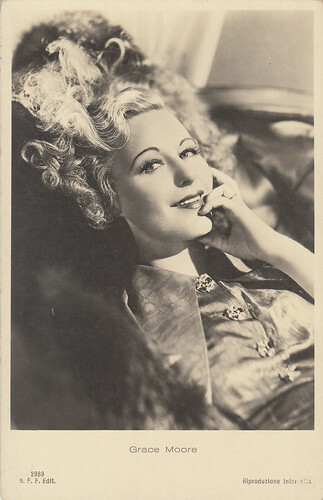
Italian postcard by B.F.F. Edit., no. 2989.
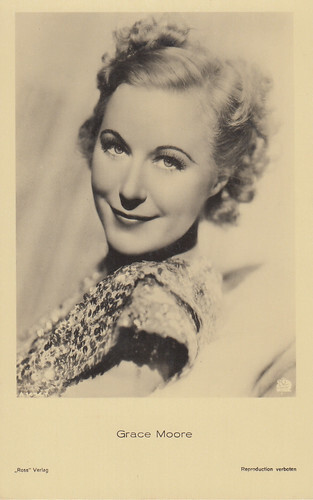
German postcard by Ross Verlag, no. A 1454/1, 1937-1938. Photo: 20th Century Fox.
Last years on stage
After her movie career had ended, Grace Moore appeared in 'Louise' several times at the Metropolitan Opera.
She could be seen there in other operas as well, such as Massenet’s 'Manon' or Puccini’s 'Tosca'.
She also toured in America and Europe and, during World War II, devoted much time and energy to entertain the U.S. Armed Forces.
During a Scandinavian tour, Grace Moore died in a plane crash in Copenhagen on the 26th of January 1946.
In 1953, Kathryn Grayson portrayed her in So This Is Love, a rather fictionalised biopic which depicts Grace Moore’s rise to fame.
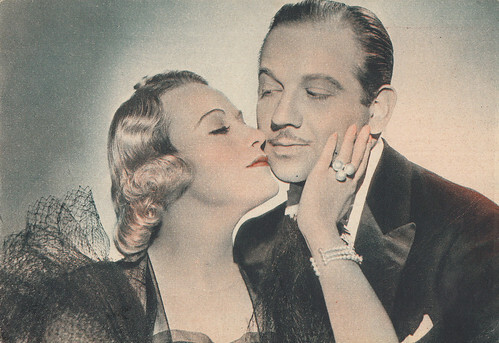
Italian postcard by Vecchioni & Guadagno, Roma. Grace Moore and Melvyn Douglas in I’ll Take Romance (Edward H. Griffith, 1937).
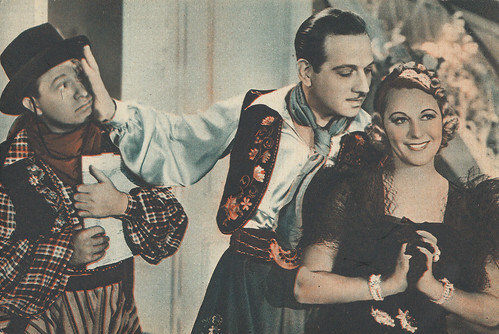
Italian postcard by Vecchioni & Guadagno, Roma. Grace Moore, Melvyn Douglas and Stuart Erwin in I’ll Take Romance (Edward H. Griffith, 1937).
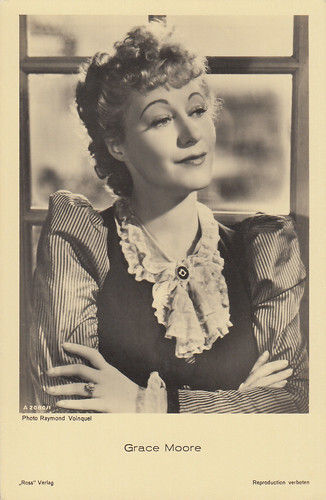
German postcard by Ross Verlag, no. A 2080/1, 1939-1940. Photo: Raymond Voinquel. Grace Moore in Louise (Abel Gance, 1939).
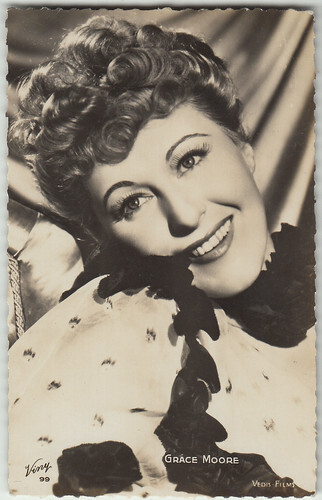
French postcard by Viny, no. 99. Photo: Vedis Films. Grace Moore in Louise (Abel Gance, 1939).
Text and postcards: Marlene Pilaete.

German postcard by Ross Verlag, no. 6242/1, 1931-1932. Photo: Metro-Goldwyn-Mayer. Grace Moore in A Lady’s Morals (Sidney Franklin, 1930).

Belgian postcard by P.I.A. Belgaphot, Bruxelles, no. 75. Photo: MGM.

Dutch postcard, no. 669.

German postcard by Ross Verlag, no. 7073/1, 1931-1932. Photo: d'Ora, Paris.
From Slabtown to the Metropolitan Opera
Grace Moore was born Mary Willie Grace Moore on the 5th of December 1898 in Slabtown, Tennessee, U.S.A.
At the end of the 10’s, she got voice training at the Wilson-Greene School of Music in Washington and, in 1919, she went to New York to start a stage career. In 1920, she appeared for the first time on Broadway in the musical 'Hitchy-Koo'.
She soon went to Paris, where she continued her musical training. When she got short of funds, she came back to the U.S.A. and successfully appeared on Broadway in 'The Music Box Revue' of 1923 (1923-1924) and 'The Music Box Revue of 1924' (1924-1925).
As her goal was to become an opera singer, she returned to Europe in 1925 for further classical study. After having been thoroughly prepared musically and linguistically for an operatic career, she made an impression on Giulio Gatti-Casazza, the Director of the Metropolitan Opera of New York, who signed her in mid-1927.
So, she went back to her native country and made her debut at the prestigious Metropolitan as Mimi in 'La Boheme' in February 1928. That same year, she played the same role at the Opera-Comique in Paris. In 1935, she would achieve great success by playing Mimi again at Covent Garden in London.

Spanish postcard by M.C. Barcelona, no. 238.

Austrian postcard by Iris Verlag, no. 6784.

British postcard. Photo: Columbia. Grace Moore in One Night of Love (Victor Schertzinger, 1934).

British postcard in the Picturegoer Series, no. 890. Photo: Columbia.
Hollywood
Under contract to M.G.M., Grace Moore made her screen debut in A Lady’s Morals (1930) and was also featured in its French-language version, Jenny Lind (1931). She co-starred with Metropolitan tenor Lawrence Tibbett in New Moon (1930).
Unfortunately, A Lady’s Morals and New Moon didn’t fare especially well at the box office and M.G.M. dropped her. She had to wait a few years more until Hollywood beckoned again.
It happened when Harry Cohn, head of Columbia, noticed her on Broadway in the operetta 'The Dubarry' (1932-1933) and signed her. Her first film at Columbia, One Night of Love (1934), was a smash hit and eventually made her a full-fledged movie star. This movie gave movie audiences the opportunity to hear her sing several arias from famous operas such as 'Carmen', 'La Traviata' or 'Madame Butterfly'.It was followed by another success, Love Me Forever (1935).
In 1935, she was awarded a medal by the Society of Arts and Science for her achievement in raising the standard of cinema entertainment. Suddenly, opera became all the rage in Hollywood. Paramount signed Gladys Swarthout and R.K.O. signed Lily Pons. Even Poverty Row’s Republic Studios wanted their own diva and hired Marion Talley, who had been in 1926 the youngest prima donna to sing at the Metropolitan Opera at that time. None of them achieved the same success onscreen.
Grace Moore then played Elizabeth "Sissi" of Austria in The King Steps Out (1936), the only musical Josef von Sternberg ever directed. Her stay at Columbia ended with When You’re in Love (1937) and I’ll Take Romance (1937). In addition to her movie career, she also increased her popularity by performing on the radio.

Italian postcard by Ballerini & Fratini, Firenze, no. 2843.

British postcard by Picturegoer, no. 890a. Photo: Columbia.

Postcard from the Dutch East Indies (now Indonesia) by CTP. Photo: Columbia Pictures.

Italian postcard by B.F.F. Edit., no. 7393.
Louise
Grace Moore made her last screen appearance in Louise (1939), directed in France by Abel Gance and adapted from Gustave Charpentier’s opera.
At first, Charpentier, who was a cinema lover, was enthusiastic about the project. But, gradually, he became annoyed that many of his suggestions were not taken into consideration and became appalled by the changes which were being made to his opera.
In an interview in November 1938, he deplored the addition of several "vulgar and coarse scenes" to his work.
In a letter sent to Abel Gance the same month, he complained about the scenes that had been filmed by the director "notwithstanding his formal veto".
In the end, he was deeply disappointed by the movie and called it a "forgery" and a "shameful conspiracy" in a letter to Grace Moore in July 1939.

French postcard by A.N., Paris, no. 1032. Photo: Columbia - Osso.

Italian postcard by Vecchioni & Guadagno, Roma. Grace Moore in When You’re in Love (Robert Riskin, Harry Lachman, 1937).

Italian postcard by B.F.F. Edit., no. 2989.

German postcard by Ross Verlag, no. A 1454/1, 1937-1938. Photo: 20th Century Fox.
Last years on stage
After her movie career had ended, Grace Moore appeared in 'Louise' several times at the Metropolitan Opera.
She could be seen there in other operas as well, such as Massenet’s 'Manon' or Puccini’s 'Tosca'.
She also toured in America and Europe and, during World War II, devoted much time and energy to entertain the U.S. Armed Forces.
During a Scandinavian tour, Grace Moore died in a plane crash in Copenhagen on the 26th of January 1946.
In 1953, Kathryn Grayson portrayed her in So This Is Love, a rather fictionalised biopic which depicts Grace Moore’s rise to fame.

Italian postcard by Vecchioni & Guadagno, Roma. Grace Moore and Melvyn Douglas in I’ll Take Romance (Edward H. Griffith, 1937).

Italian postcard by Vecchioni & Guadagno, Roma. Grace Moore, Melvyn Douglas and Stuart Erwin in I’ll Take Romance (Edward H. Griffith, 1937).

German postcard by Ross Verlag, no. A 2080/1, 1939-1940. Photo: Raymond Voinquel. Grace Moore in Louise (Abel Gance, 1939).

French postcard by Viny, no. 99. Photo: Vedis Films. Grace Moore in Louise (Abel Gance, 1939).
Text and postcards: Marlene Pilaete.
Published on October 30, 2023 23:00
October 29, 2023
Stanley Baker
Welsh actor and film producer Stanley Baker (1928-1976) started as a tough and gritty villain in the British cinema of the 1950s. Later he became a star as a rugged working class anti-hero in many international productions. Several of his films dealt with African themes, most notably Zulu (1964).
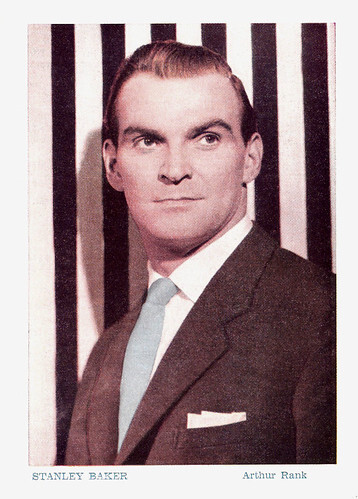
Belgian collector's card by Merbotek, Bruxelles. Photo: Arthur Rank.
Wild kid only interested in football and boxing
William Stanley ‘Stan’ Baker was born in the heart of mining community Ferndale, Wales, in 1928 as the youngest of three children. His father was a coal miner who lost a leg in a mine accident. Thereafter he was unemployed until the Second World War took men away into the services and he got work as a truck driver. Baker moved to London with his parents in the mid-1930s.
Stan grew up a self-proclaimed ‘wild kid only interested in football and boxing’, but his potential was recognised by a local teacher, Glynne Morse, who encouraged Baker to act. When he was 14, he was seen in a school play by a casting director from Ealing Studios. The casting director recommended the boy for a role in the war film Undercover (Sergei Nolbandov, 1943), about the Yugoslav guerrillas in German-occupied Serbia. Baker was paid £20 a week and caught the acting bug, deciding to become a professional actor.
Six months later he appeared on the West End alongside a young Richard Burton in Emlyn Williams ’ play The Druid's Rest (1943). Baker worked for a time as an apprentice electrician. Then through Morse's influence he managed to secure a position with the Birmingham Repertory Theatre in 1944. Three years later, he was called up to do his National Service. He served in the Royal Army Service Corps until 1948, achieving the rank of sergeant. After demobilisation he moved to London determined to resume his acting career. David Wishart at IMDb : “His was good-looking, but his features were angular, taut, austere and unwelcoming. His screen persona was taciturn, even surly, and the young actor displayed a predilection for introspection and blunt speaking, and was almost wilfully unromantic.” At Richard Burton 's recommendation, he was cast in a small role in a play on the West End, Adventure Story by Terence Rattigan.
He began appearing in films and on television, as well performing on stage for the Middlesex Repertory Company. His breakthrough came in Christopher Fry's anti-war play 'A Sleep of Prisoners' (1950) alongside Denholm Elliott. The production later toured the United States. Baker impressed in the cinema as Hornblower’s bosun in the Hollywood-financed Captain Horatio Hornblower R.N. (Raoul Walsh, 1951) featuring Gregory Peck . While appearing in A Sleep of Prisoners in New York, Baker read the novel 'The Cruel Sea'. Attracted to the idea of playing the unpleasant and somewhat cowardly Bennett, he lobbied successfully for the role in the film version, The Cruel Sea (Charles Frend, 1953) with Jack Hawkins . This WWII drama was the most successful film at the British box office in 1953 and was also a surprising hit in the USA.
This success really established Baker in films, and led to a Hollywood offer when George Sanders fell ill and was unable to play Sir Mordred in the cinemascope epic Knights of the Round Table (Richard Thorpe, 1953) starring Robert Taylor . Baker proved a unique screen presence - tough, gritty, combustible - and possessing an aura of dark, even menacing power. Baker's performance was received favourably and he soon developed a niche playing villains in films such as Hell Below Zero (Mark Robson, 1954) starring Alan Ladd . His career received another boost when Laurence Olivier selected Baker to play Henry Tudor in Richard III (1955). He went on to play two important roles in other Hollywood costume epics: Achilles in Helen of Troy (Robert Wise, 1956) featuring Rossana Podestà , and Attalus in Alexander the Great (Robert Rossen, 1956) starring Richard Burton as Alexander.
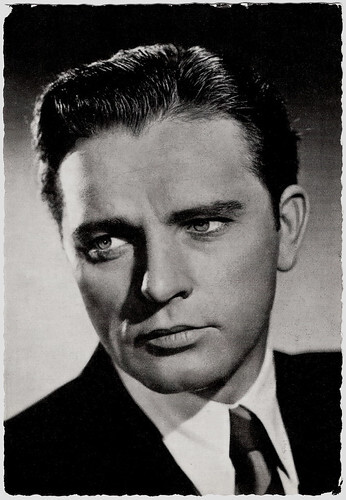
Richard Burton . German postcard by WS-Druck, Wanne-Eickel, no. 226. Offered by Macaroni Honig, Gent (Belgium). Photo: Centfox.
A tough anti-hero
Stanley Baker finally broke away from supporting parts when cast as the lead in Hell Drivers (Cy Endfield, 1957). Mark Deming at AllMovie : "In this efficient British crime drama, Tom Yately (Stanley Baker) is an ex-con looking for honest work. He thinks he's found it when he takes a job as a truck driver, but he soon discovers that the trucking firm he's signed on with is not playing by the rules." The blacklisted American screenwriter-director Cy Endfield had first worked with Baker on Child in the House (1956) and went on to make six films in total with the actor.
The success of Hell Drivers established Baker as a star and saw exhibitors vote him the 7th most popular British actor that year. He followed this up with a series of popular films that featured him as a tough anti-hero, usually an authority figure of some kind. These films include Violent Playground (Basil Dearden, 1958) with Peter Cushing, Sea Fury (Cy Endfield, 1958), Yesterday's Enemy (Val Guest, 1959) and the murder mystery Blind Date (Joseph Losey, 1959) with Hardy Krüger .
The latter was the first of what would be four collaborations with director Joseph Losey of which his favourite was the prison drama The Criminal (1960) in which he played an unscrupulous mobster. The fourth was Eva (1962) with Jeanne Moreau . In 1959 his contract with Rank ended, and he started freelancing. In 1961 Baker was offered the role of superspy James Bond for the forthcoming film Dr. No (Terence Young, 1961), but he turned it down because he was unwilling to commit to a three-picture contract. He may have regretted this decision because some years later he asked producer Albert R. Broccoli about playing a villain in one of the films.
However, he was cast as Butcher Brown, a war-weary commando in the blockbuster war epic The Guns of Navarone (J. Lee Thompson, 1961) with Gregory Peck and David Niven . Baker wanted to move into production, and to this end formed his own company, Diamond Films. While making Sodom and Gomorrah (Robert Aldrich, 1963) he struck up a relationship with producer Joseph E. Levine which enabled him to raise the money for the historical war film Zulu (Cy Endfield, 1964), depicting the Battle of Rorke's Drift between the British Army and the Zulus in January 1879.
Zulu was a massive success at the box office and helped make a star of Michael Caine . Baker played the lead part of Lieutenant John Chard VC in what remains his best-remembered-role. Baker later owned Chard's Victoria Cross and Zulu War Medal from 1972 until his death in 1976. Chard died at age 49 in 1897, only a year older than Baker at his death; both died of cancer. Baker then made two more films in Africa, Dingaka (Jamie Uys, 1965) and Sands of the Kalahari (Cy Endfield, 1965), also producing the latter. Neither was as successful as Zulu.
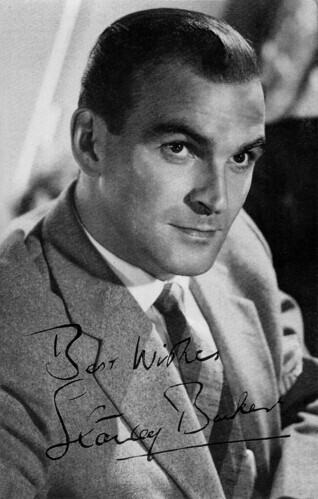
British postcard by Celebrity Publishers, London, in the Celebrity Autograph Series, no. 267. Photo: Rank Organisation. Publicity still for Hell Drivers (Cy Endfield, 1957).
A brilliantly offhand portrait
Stanley Baker formed another production company, Oakhurst Productions, in association with Michael Deeley. They produced such films as Robbery (Peter Yates, 1967) inspired by the Great Train Robbery, the classic The Italian Job (Peter Collinson, 1968) and Where's Jack? (James Clavell, 1969). Baker starred in some of these and continued to act for other producers, giving one of his best performances in Joseph Losey's Accident (1967) opposite Dirk Bogarde . John Baxter at Film Reference : “he offered a brilliantly offhand portrait of an academic-turned-media-hero, narcissistic, petulant, languid, effortlessly agile in argument but helpless in anything requiring a trace of humanity.”
In the 1970s Baker expanded his business interests. He was one of the founder members of Harlech Television and continued to be a director of it up until his death. With Michael Deeley and Barry Spikings, he formed Great Western Enterprises, which were involved in a number of projects in the entertainment field, notably music concerts, and bought a large building on the River Thames. They were also part of a consortium that bought British Lion Films and Shepperton Studios, selling their building in order to finance it.
Baker was the victim of bad timing. The British film industry went into serious decline at the end of the 1960s, and a number of Oakhurst films were unsuccessful at the box office. His expansion into music festivals was ultimately disastrous, with the Great Western Bardney Pop Festival in Lincoln ending up losing ₤200,000. The British stock market crashed at the end of 1973, throwing the over-leveraged British Lion into turmoil. According to Wikipedia , Baker was forced to keep acting to pay the bills, accepting roles in poor films which affected his star status.
However, at least interesting is the giallo Una lucertola con la pelle di donna/A Lizard in a Woman's Skin (Lucio Fulci, 1971) with Florinda Bolkan and Jean Sorel . At AllMovie , Donald Guarisco reviews: “The storyline enthusiastic piles soap-opera melodramatics, crazy plot twists, red herrings, bad-trip dream sequences and a healthy lashing of skin and blood. Fulci's direction lives up to the story's fever-pitch thriller theatrics with a barrage of baroque visual trickery, using everything from split-screens to colorful optical effects to keep the viewer off-kilter.” Towards the end of his life Baker pulled back on his business activities and worked mostly as an actor, taking roles in television including the BBC plays The Changeling (Anthony Page, 1974) with Helen Mirren, Robinson Crusoe (James MacTaggart, 1974), and the series How Green Was My Valley (Ronald Wilson, 1975). His final film was Zorro (Duccio Tessari, 1975) starring Alain Delon as Diego de la Vega/Zorro and Baker as his opponent Colonel Huerta.
On 27 May 1976 it was announced that Baker was to be awarded a knighthood but he did not live to be invested in person at Buckingham Palace. So he cannot be referred to as 'Sir'. A heavy cigarette and cigar smoker, he was diagnosed with lung cancer in January 1976 and underwent surgery in the following month. However, the cancer had spread to his bones and he died that same year from pneumonia in Málaga, Spain, aged 48. In a floral tribute sent to his funeral, Zulu leader Chief Mangosuthu Buthelezi who had worked with him at Zulu (1964) described him as ‘the most decent white man I have ever met’. Since 1950 Stanley Baker was married to actress Ellen Martin. She had been introduced to him by Richard Burton . Their partnership lasted until his death and produced four children, Martin and Sally (twins), Glyn and Adam.
>
Trailer Zulu (1964). Source: YouTubeMovies (YouTube).
Trailer Accident (1967). Source: Cheltenhamff (YouTube).
Sources: John Baxter (Film Reference), (IMDb), Brian McFarlane (Encyclopedia of British Film), Donald Guarisco (AllMovie), Mark Deming (AllMovie), Hal Erickson (AllMovie), BBC Wales, The Sir Stanley Baker Tribute Site (now defunct), Wikipedia, and .

Belgian collector's card by Merbotek, Bruxelles. Photo: Arthur Rank.
Wild kid only interested in football and boxing
William Stanley ‘Stan’ Baker was born in the heart of mining community Ferndale, Wales, in 1928 as the youngest of three children. His father was a coal miner who lost a leg in a mine accident. Thereafter he was unemployed until the Second World War took men away into the services and he got work as a truck driver. Baker moved to London with his parents in the mid-1930s.
Stan grew up a self-proclaimed ‘wild kid only interested in football and boxing’, but his potential was recognised by a local teacher, Glynne Morse, who encouraged Baker to act. When he was 14, he was seen in a school play by a casting director from Ealing Studios. The casting director recommended the boy for a role in the war film Undercover (Sergei Nolbandov, 1943), about the Yugoslav guerrillas in German-occupied Serbia. Baker was paid £20 a week and caught the acting bug, deciding to become a professional actor.
Six months later he appeared on the West End alongside a young Richard Burton in Emlyn Williams ’ play The Druid's Rest (1943). Baker worked for a time as an apprentice electrician. Then through Morse's influence he managed to secure a position with the Birmingham Repertory Theatre in 1944. Three years later, he was called up to do his National Service. He served in the Royal Army Service Corps until 1948, achieving the rank of sergeant. After demobilisation he moved to London determined to resume his acting career. David Wishart at IMDb : “His was good-looking, but his features were angular, taut, austere and unwelcoming. His screen persona was taciturn, even surly, and the young actor displayed a predilection for introspection and blunt speaking, and was almost wilfully unromantic.” At Richard Burton 's recommendation, he was cast in a small role in a play on the West End, Adventure Story by Terence Rattigan.
He began appearing in films and on television, as well performing on stage for the Middlesex Repertory Company. His breakthrough came in Christopher Fry's anti-war play 'A Sleep of Prisoners' (1950) alongside Denholm Elliott. The production later toured the United States. Baker impressed in the cinema as Hornblower’s bosun in the Hollywood-financed Captain Horatio Hornblower R.N. (Raoul Walsh, 1951) featuring Gregory Peck . While appearing in A Sleep of Prisoners in New York, Baker read the novel 'The Cruel Sea'. Attracted to the idea of playing the unpleasant and somewhat cowardly Bennett, he lobbied successfully for the role in the film version, The Cruel Sea (Charles Frend, 1953) with Jack Hawkins . This WWII drama was the most successful film at the British box office in 1953 and was also a surprising hit in the USA.
This success really established Baker in films, and led to a Hollywood offer when George Sanders fell ill and was unable to play Sir Mordred in the cinemascope epic Knights of the Round Table (Richard Thorpe, 1953) starring Robert Taylor . Baker proved a unique screen presence - tough, gritty, combustible - and possessing an aura of dark, even menacing power. Baker's performance was received favourably and he soon developed a niche playing villains in films such as Hell Below Zero (Mark Robson, 1954) starring Alan Ladd . His career received another boost when Laurence Olivier selected Baker to play Henry Tudor in Richard III (1955). He went on to play two important roles in other Hollywood costume epics: Achilles in Helen of Troy (Robert Wise, 1956) featuring Rossana Podestà , and Attalus in Alexander the Great (Robert Rossen, 1956) starring Richard Burton as Alexander.

Richard Burton . German postcard by WS-Druck, Wanne-Eickel, no. 226. Offered by Macaroni Honig, Gent (Belgium). Photo: Centfox.
A tough anti-hero
Stanley Baker finally broke away from supporting parts when cast as the lead in Hell Drivers (Cy Endfield, 1957). Mark Deming at AllMovie : "In this efficient British crime drama, Tom Yately (Stanley Baker) is an ex-con looking for honest work. He thinks he's found it when he takes a job as a truck driver, but he soon discovers that the trucking firm he's signed on with is not playing by the rules." The blacklisted American screenwriter-director Cy Endfield had first worked with Baker on Child in the House (1956) and went on to make six films in total with the actor.
The success of Hell Drivers established Baker as a star and saw exhibitors vote him the 7th most popular British actor that year. He followed this up with a series of popular films that featured him as a tough anti-hero, usually an authority figure of some kind. These films include Violent Playground (Basil Dearden, 1958) with Peter Cushing, Sea Fury (Cy Endfield, 1958), Yesterday's Enemy (Val Guest, 1959) and the murder mystery Blind Date (Joseph Losey, 1959) with Hardy Krüger .
The latter was the first of what would be four collaborations with director Joseph Losey of which his favourite was the prison drama The Criminal (1960) in which he played an unscrupulous mobster. The fourth was Eva (1962) with Jeanne Moreau . In 1959 his contract with Rank ended, and he started freelancing. In 1961 Baker was offered the role of superspy James Bond for the forthcoming film Dr. No (Terence Young, 1961), but he turned it down because he was unwilling to commit to a three-picture contract. He may have regretted this decision because some years later he asked producer Albert R. Broccoli about playing a villain in one of the films.
However, he was cast as Butcher Brown, a war-weary commando in the blockbuster war epic The Guns of Navarone (J. Lee Thompson, 1961) with Gregory Peck and David Niven . Baker wanted to move into production, and to this end formed his own company, Diamond Films. While making Sodom and Gomorrah (Robert Aldrich, 1963) he struck up a relationship with producer Joseph E. Levine which enabled him to raise the money for the historical war film Zulu (Cy Endfield, 1964), depicting the Battle of Rorke's Drift between the British Army and the Zulus in January 1879.
Zulu was a massive success at the box office and helped make a star of Michael Caine . Baker played the lead part of Lieutenant John Chard VC in what remains his best-remembered-role. Baker later owned Chard's Victoria Cross and Zulu War Medal from 1972 until his death in 1976. Chard died at age 49 in 1897, only a year older than Baker at his death; both died of cancer. Baker then made two more films in Africa, Dingaka (Jamie Uys, 1965) and Sands of the Kalahari (Cy Endfield, 1965), also producing the latter. Neither was as successful as Zulu.

British postcard by Celebrity Publishers, London, in the Celebrity Autograph Series, no. 267. Photo: Rank Organisation. Publicity still for Hell Drivers (Cy Endfield, 1957).
A brilliantly offhand portrait
Stanley Baker formed another production company, Oakhurst Productions, in association with Michael Deeley. They produced such films as Robbery (Peter Yates, 1967) inspired by the Great Train Robbery, the classic The Italian Job (Peter Collinson, 1968) and Where's Jack? (James Clavell, 1969). Baker starred in some of these and continued to act for other producers, giving one of his best performances in Joseph Losey's Accident (1967) opposite Dirk Bogarde . John Baxter at Film Reference : “he offered a brilliantly offhand portrait of an academic-turned-media-hero, narcissistic, petulant, languid, effortlessly agile in argument but helpless in anything requiring a trace of humanity.”
In the 1970s Baker expanded his business interests. He was one of the founder members of Harlech Television and continued to be a director of it up until his death. With Michael Deeley and Barry Spikings, he formed Great Western Enterprises, which were involved in a number of projects in the entertainment field, notably music concerts, and bought a large building on the River Thames. They were also part of a consortium that bought British Lion Films and Shepperton Studios, selling their building in order to finance it.
Baker was the victim of bad timing. The British film industry went into serious decline at the end of the 1960s, and a number of Oakhurst films were unsuccessful at the box office. His expansion into music festivals was ultimately disastrous, with the Great Western Bardney Pop Festival in Lincoln ending up losing ₤200,000. The British stock market crashed at the end of 1973, throwing the over-leveraged British Lion into turmoil. According to Wikipedia , Baker was forced to keep acting to pay the bills, accepting roles in poor films which affected his star status.
However, at least interesting is the giallo Una lucertola con la pelle di donna/A Lizard in a Woman's Skin (Lucio Fulci, 1971) with Florinda Bolkan and Jean Sorel . At AllMovie , Donald Guarisco reviews: “The storyline enthusiastic piles soap-opera melodramatics, crazy plot twists, red herrings, bad-trip dream sequences and a healthy lashing of skin and blood. Fulci's direction lives up to the story's fever-pitch thriller theatrics with a barrage of baroque visual trickery, using everything from split-screens to colorful optical effects to keep the viewer off-kilter.” Towards the end of his life Baker pulled back on his business activities and worked mostly as an actor, taking roles in television including the BBC plays The Changeling (Anthony Page, 1974) with Helen Mirren, Robinson Crusoe (James MacTaggart, 1974), and the series How Green Was My Valley (Ronald Wilson, 1975). His final film was Zorro (Duccio Tessari, 1975) starring Alain Delon as Diego de la Vega/Zorro and Baker as his opponent Colonel Huerta.
On 27 May 1976 it was announced that Baker was to be awarded a knighthood but he did not live to be invested in person at Buckingham Palace. So he cannot be referred to as 'Sir'. A heavy cigarette and cigar smoker, he was diagnosed with lung cancer in January 1976 and underwent surgery in the following month. However, the cancer had spread to his bones and he died that same year from pneumonia in Málaga, Spain, aged 48. In a floral tribute sent to his funeral, Zulu leader Chief Mangosuthu Buthelezi who had worked with him at Zulu (1964) described him as ‘the most decent white man I have ever met’. Since 1950 Stanley Baker was married to actress Ellen Martin. She had been introduced to him by Richard Burton . Their partnership lasted until his death and produced four children, Martin and Sally (twins), Glyn and Adam.
>
Trailer Zulu (1964). Source: YouTubeMovies (YouTube).
Trailer Accident (1967). Source: Cheltenhamff (YouTube).
Sources: John Baxter (Film Reference), (IMDb), Brian McFarlane (Encyclopedia of British Film), Donald Guarisco (AllMovie), Mark Deming (AllMovie), Hal Erickson (AllMovie), BBC Wales, The Sir Stanley Baker Tribute Site (now defunct), Wikipedia, and .
Published on October 29, 2023 23:00
October 28, 2023
Nino Castelnuovo
Handsome and athletic Italian actor Nino Castelnovo's (1936-2021) most famous role was as Guy Foucher opposite Catherine Deneuve in the classic French music drama Les parapluies de Cherbourg/The Umbrellas of Cherbourg (1964).
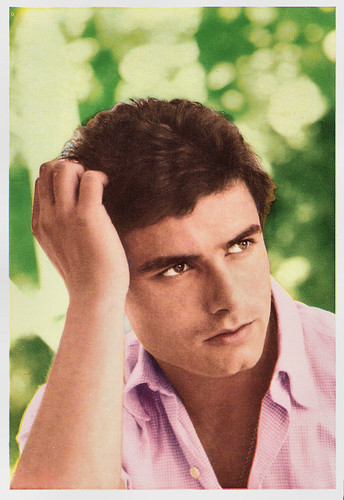
Spanish postcard by Archivo Bermejo, no. C-202, 1964. Caption: actor of the Eastmancolor film Les parapluies de Cherbourg/The Umbrellas of Cherbourg by Radio Films. Retail price: 5 Ptas.
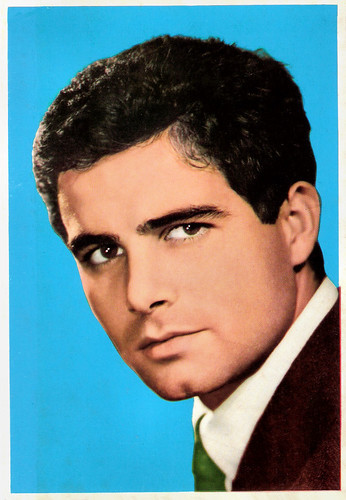
Spanish postcard by Archivo Bermejo, no. C-254, 1965. Caption: actor of the Eastmancolor film Les parapluies de Cherbourg/The Umbrellas of Cherbourg by Radio Films.
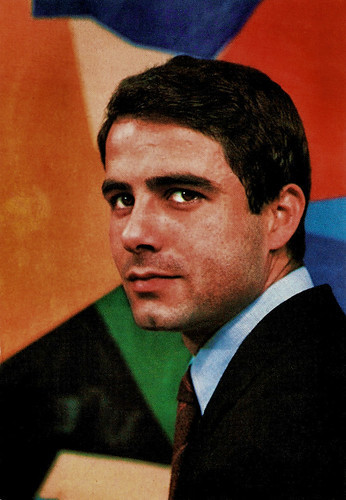
Spanish postcard by Postal Oscarcolor, no. 396.
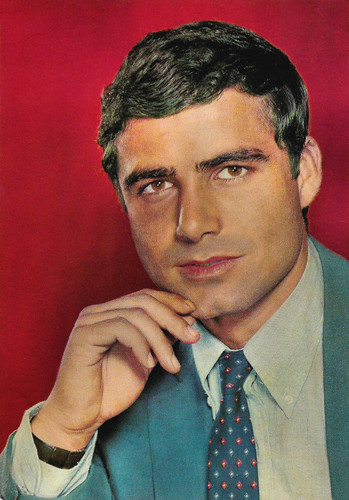
Spanish postcard by Postal Oscarcolor, no. 476. Photo: RCA Victor / 20th Century Fox.
The Umbrellas of Cherbourg
Francesco 'Nino' Castelnuovo was born to humble beginnings in Lecco, Lombardy, in 1936. He had two older brothers, Pierantonio and Clemente. His working life began with a series of stints in various jobs, including house painting, as a mechanic, and as a workman. He moved to Milan where he worked as a sales agent and took drama classes at the Piccolo Teatro in Milan.
He debuted on-screen as a mime in the RAI children's television show Zurli il mago del giovedì/Zurli the Wizard of Thursday. His film debut followed two years later in Un maledetto imbroglio/The Facts of Murder (Pietro Germi, 1959). He also had a small supporting part in Luchino Visconti 's classic Rocco e i suoi fratelli/Rocco and His Brothers (1960).
When the American television show Disneyland travelled to Italy in 1962, he appeared with Annette Funicello in two episodes of the mini-movie, Escapade in Florence, singing, playing the guitar, and adding the Italian verses to the jovial tarantella 'Dream Boy'.
His career gained traction with a co-starring role opposite Catherine Deneuve in the romantic musical drama Les parapluies de Cherbourg/The Umbrellas of Cherbourg (Jacques Demy, 1964) though his scenes were subsequently re-dubbed by José Bartel. Nominated for the American Academy Award for Best Foreign Language Film, the film gained the attention of both film critics and the public and won the Palme d'Or at the Cannes Film Festival in February of the same year.
Castelnuovo's greatest popularity came via the small screen, as Renzo Tramaglino, the key protagonist of the mini-series I promessi sposi/The Betrothed (Sandro Bolchi, 1967), a period piece set during the Spanish occupation of Lombardy in the 17th century and based on a best-selling novel by Alessandro Manzoni . Other appearances have included both American and Italian-produced Westerns like The Reward (Serge Bourguignon, 1965) with Max von Sydow, and the Zapata Western Un esercito di 5 uomini/The 5-Man Army (Don Taylor, Italo Zingarelli, 1969) starring Bud Spencer . It featured a script by a young Dario Argento and a score by Ennio Morricone.
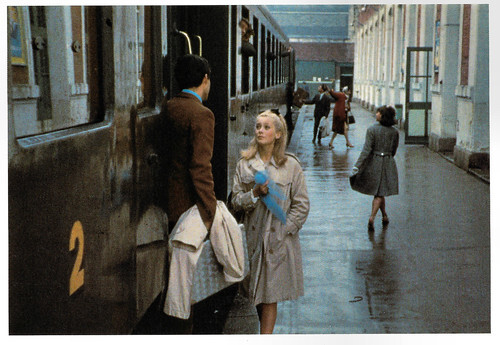
French postcard by La Cinémathèque française, no. CF 5004, 1998. Photo: Ciné Tamaris / Collection C.T. Catherine Deneuve and Nino Castelnuovo in Les parapluies de Cherbourg (Jacques Demy, 1964).
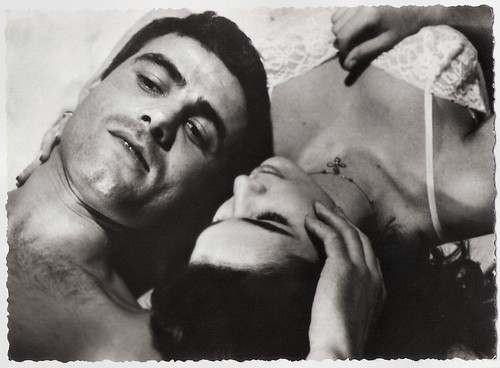
Vintage postcard. Nino Castelnuovo and Christine Delaroche in Un monde nouveau/A New World (Vittorio De Sica, 1966).
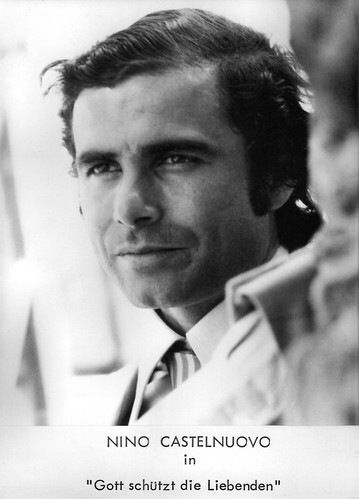
German postcard. Nino Castelnuovo in Gott schützt die Liebenden/God protects the lovers (Alfred Vohrer, 1973).
A low-budget Italian space opera produced in the wake of Star Wars
Nino Castelnuovo appeared as Armand Duval opposite Danièle Gaubert in Camille 2000 (1969), directed by Radley Metzger. The film is based on the 1848 novel and 1852 play 'La Dame aux Camélias' by Alexandre Dumas, fils . It was adapted by Michael DeForrest.
His later films included L'emmerdeur/A Pain in the Ass (Édouard Molinaro, 1973) with Jacques Brel and Lino Ventura , and the Gothic horror film Il prato macchiato di rosso/The Red-stained Lawn (Riccardo Ghione, 1973),
By the early 1970s, Castelnuovo acted primarily on stage, and in serial television. From 1977 to 1982, he was seen as the athletically sound spokesman in commercials for the corn-oil company Cuore. One of his few later film performances was a supporting part in the Science Fiction film Sette uomini d'oro nello spazio/Star Odyssey (Alfonso Brescia, 1979). It was the last of four low-budget Italian space opera films produced in the wake of Star Wars by Italian director Alfonso Brescia under the pseudonym Al Bradley.
His final fling on the international scene was a small role as D'Agostino in The English Patient (Anthony Minghella, 1996) as an archaeologist, recalled in flashback scenes by the lead character Almásy (Ralph Fiennes). He continued to be active on the Italian theatre stage. In 2002, he starred in a production of the 1931 comedy play 'The Front Page'. Castelnuovo retired in 2016. His last film was The Legacy Run (Massimiliano Mazza, 2016) with sports personalities Daniela Scalia, Luca Tramontin, and Marco Baron.
Nino Castelnuovo passed away after a long illness in Rome in 2021. He was 84. Castelnuovo had a son, Lorenzo, with actress Danila Trebbi. Since 2010, he has been married to actress Maria Cristina Di Nicola.
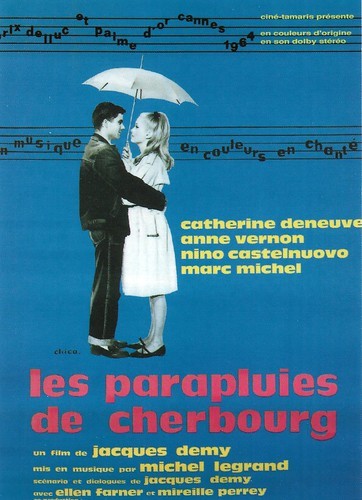
French postcard by Sonis for Cine Tamaris, Paris. Poster design by Chico. Nino Castelnuovo and Catherine Deneuve in Les parapluies de Cherbourg/The Umbrellas of Cherbourg (Jacques Demy, 1964).
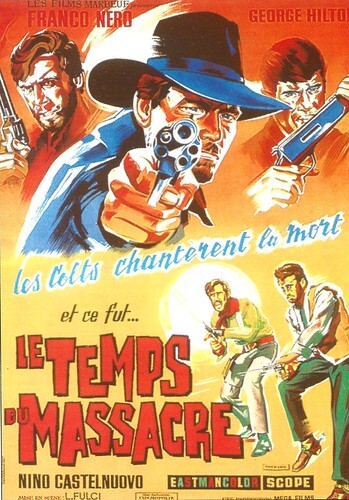
French postcard by Encyclopédie du ciné, Paris. Poster design: Constantin Belinsky. French affiche for Le colt cantarono la morte e fu... tempo di massacro/ Massacre Time/ Django the Runner/ Colt Concert (Lucio Fulci, 1966), with Franco Nero, George Hilton and Nino Castelnuovo. The French title was Le temps du massacre/ Les Colts chanterent la mort et ce fut... le temps du massacre.
Nino Castelnuovo in a commercial for the corn oil company Cuore. Source: Tutto Spot 80 (YouTube).
Sources: (IMDb), Wikipedia, and .

Spanish postcard by Archivo Bermejo, no. C-202, 1964. Caption: actor of the Eastmancolor film Les parapluies de Cherbourg/The Umbrellas of Cherbourg by Radio Films. Retail price: 5 Ptas.

Spanish postcard by Archivo Bermejo, no. C-254, 1965. Caption: actor of the Eastmancolor film Les parapluies de Cherbourg/The Umbrellas of Cherbourg by Radio Films.

Spanish postcard by Postal Oscarcolor, no. 396.

Spanish postcard by Postal Oscarcolor, no. 476. Photo: RCA Victor / 20th Century Fox.
The Umbrellas of Cherbourg
Francesco 'Nino' Castelnuovo was born to humble beginnings in Lecco, Lombardy, in 1936. He had two older brothers, Pierantonio and Clemente. His working life began with a series of stints in various jobs, including house painting, as a mechanic, and as a workman. He moved to Milan where he worked as a sales agent and took drama classes at the Piccolo Teatro in Milan.
He debuted on-screen as a mime in the RAI children's television show Zurli il mago del giovedì/Zurli the Wizard of Thursday. His film debut followed two years later in Un maledetto imbroglio/The Facts of Murder (Pietro Germi, 1959). He also had a small supporting part in Luchino Visconti 's classic Rocco e i suoi fratelli/Rocco and His Brothers (1960).
When the American television show Disneyland travelled to Italy in 1962, he appeared with Annette Funicello in two episodes of the mini-movie, Escapade in Florence, singing, playing the guitar, and adding the Italian verses to the jovial tarantella 'Dream Boy'.
His career gained traction with a co-starring role opposite Catherine Deneuve in the romantic musical drama Les parapluies de Cherbourg/The Umbrellas of Cherbourg (Jacques Demy, 1964) though his scenes were subsequently re-dubbed by José Bartel. Nominated for the American Academy Award for Best Foreign Language Film, the film gained the attention of both film critics and the public and won the Palme d'Or at the Cannes Film Festival in February of the same year.
Castelnuovo's greatest popularity came via the small screen, as Renzo Tramaglino, the key protagonist of the mini-series I promessi sposi/The Betrothed (Sandro Bolchi, 1967), a period piece set during the Spanish occupation of Lombardy in the 17th century and based on a best-selling novel by Alessandro Manzoni . Other appearances have included both American and Italian-produced Westerns like The Reward (Serge Bourguignon, 1965) with Max von Sydow, and the Zapata Western Un esercito di 5 uomini/The 5-Man Army (Don Taylor, Italo Zingarelli, 1969) starring Bud Spencer . It featured a script by a young Dario Argento and a score by Ennio Morricone.

French postcard by La Cinémathèque française, no. CF 5004, 1998. Photo: Ciné Tamaris / Collection C.T. Catherine Deneuve and Nino Castelnuovo in Les parapluies de Cherbourg (Jacques Demy, 1964).

Vintage postcard. Nino Castelnuovo and Christine Delaroche in Un monde nouveau/A New World (Vittorio De Sica, 1966).

German postcard. Nino Castelnuovo in Gott schützt die Liebenden/God protects the lovers (Alfred Vohrer, 1973).
A low-budget Italian space opera produced in the wake of Star Wars
Nino Castelnuovo appeared as Armand Duval opposite Danièle Gaubert in Camille 2000 (1969), directed by Radley Metzger. The film is based on the 1848 novel and 1852 play 'La Dame aux Camélias' by Alexandre Dumas, fils . It was adapted by Michael DeForrest.
His later films included L'emmerdeur/A Pain in the Ass (Édouard Molinaro, 1973) with Jacques Brel and Lino Ventura , and the Gothic horror film Il prato macchiato di rosso/The Red-stained Lawn (Riccardo Ghione, 1973),
By the early 1970s, Castelnuovo acted primarily on stage, and in serial television. From 1977 to 1982, he was seen as the athletically sound spokesman in commercials for the corn-oil company Cuore. One of his few later film performances was a supporting part in the Science Fiction film Sette uomini d'oro nello spazio/Star Odyssey (Alfonso Brescia, 1979). It was the last of four low-budget Italian space opera films produced in the wake of Star Wars by Italian director Alfonso Brescia under the pseudonym Al Bradley.
His final fling on the international scene was a small role as D'Agostino in The English Patient (Anthony Minghella, 1996) as an archaeologist, recalled in flashback scenes by the lead character Almásy (Ralph Fiennes). He continued to be active on the Italian theatre stage. In 2002, he starred in a production of the 1931 comedy play 'The Front Page'. Castelnuovo retired in 2016. His last film was The Legacy Run (Massimiliano Mazza, 2016) with sports personalities Daniela Scalia, Luca Tramontin, and Marco Baron.
Nino Castelnuovo passed away after a long illness in Rome in 2021. He was 84. Castelnuovo had a son, Lorenzo, with actress Danila Trebbi. Since 2010, he has been married to actress Maria Cristina Di Nicola.

French postcard by Sonis for Cine Tamaris, Paris. Poster design by Chico. Nino Castelnuovo and Catherine Deneuve in Les parapluies de Cherbourg/The Umbrellas of Cherbourg (Jacques Demy, 1964).

French postcard by Encyclopédie du ciné, Paris. Poster design: Constantin Belinsky. French affiche for Le colt cantarono la morte e fu... tempo di massacro/ Massacre Time/ Django the Runner/ Colt Concert (Lucio Fulci, 1966), with Franco Nero, George Hilton and Nino Castelnuovo. The French title was Le temps du massacre/ Les Colts chanterent la mort et ce fut... le temps du massacre.
Nino Castelnuovo in a commercial for the corn oil company Cuore. Source: Tutto Spot 80 (YouTube).
Sources: (IMDb), Wikipedia, and .
Published on October 28, 2023 23:00
October 27, 2023
John Boles
John Boles (1895-1969) was an American singer and actor best known for playing Victor Moritz in the Horror classic Frankenstein (1931). He started out in Hollywood in silent films but became a huge star with the advent of talkies.
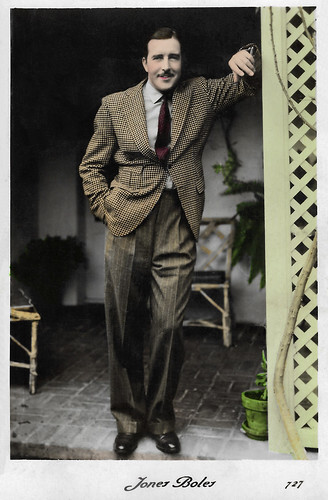
French postcard, no. 727.
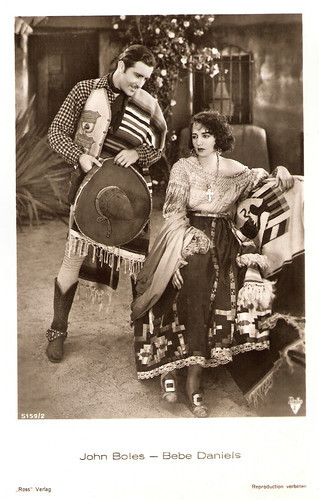
German postcard by Ross Verlag, no. 51592, 1930-1931. Photo: Radio Pictures (RKO). Bebe Daniels and John Boles in Rio Rita (Luther Reed, 1929).
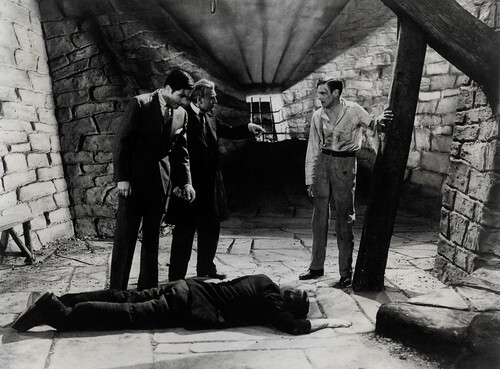
Vintage photo. John Boles, Edward Van Sloan, Colin Clive and Boris Karloff in Frankenstein (James Whale, 1931).
Audiences were enthralled by his beautiful voice
John Boles was born in Greenville, Texas, to a middle-class family. He graduated from the University of Texas in 1917. Boles served in the intelligence service of the U.S. Army during World War I. He returned to Greenville, where he was selected by an out-of-town producer to act in an opera at the King Opera House. This experience convinced John that he preferred music and the stage to the preference of his parents, who wanted him to pursue a medical degree.
While en route to a career as an actor and singer, Boles earned a living by teaching French and singing in a high school in New York State and working as a business manager and interpreter for a one-year tour of Europe by a student group. The latter venture led to his studying under tenor Jean de Reszke. Boles married Marcelite Dobbs in 1917, and they remained married until his death.
After the First World War, Boles moved to New York to study music. He quickly became well-known for his talents and was selected to replace the leading man in the 1923 Broadway musical 'Little Jesse James'. He became an established star on Broadway. Boles' other Broadway credits include 'Mercenary Mary' (1924), and 'Kitty's Kisses' (1925). It attracted the attention of Hollywood producers.
He was hired by MGM to appear in the silent film The Sixth Commandment (Christy Cabanne, 1924). He starred in two more films for that studio before returning to New York and the stage. In 1927, he returned to Hollywood to star in The Love of Sunya (Albert Parker, 1927) opposite Gloria Swanson , which was a big success for him. Unfortunately, because the movies were still silent he was unable to show off his singing ability.
In 1929, Warner Brothers hired him to star in their lavish musical operetta The Desert Song (Roy Del Ruth, 1929). This film featured sequences in Technicolor and was a box-office success. Soon after, Radio Pictures (later known as RKO) selected him to play the leading man in their extravagant production Rio Rita (Luther Reed, 1929), opposite Bebe Daniels . The last portion of the film was photographed in Technicolor. Audiences were enthralled by his beautiful voice, and John Boles suddenly found himself in huge demand. RCA Victor even hired him to make phonograph records of songs that he had sung in his films.
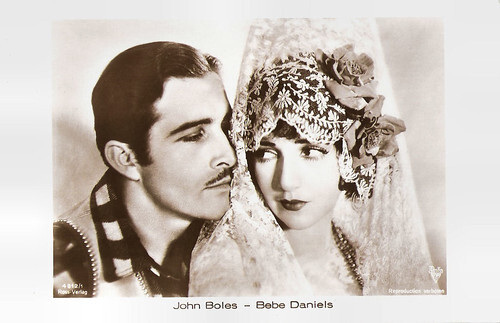
German postcard by Ross Verlag, no. 4812/1, 1929-1930. Photo: Radio Pictures (RKO). Bebe Daniels and John Boles in Rio Rita (Luther Reed, 1929).
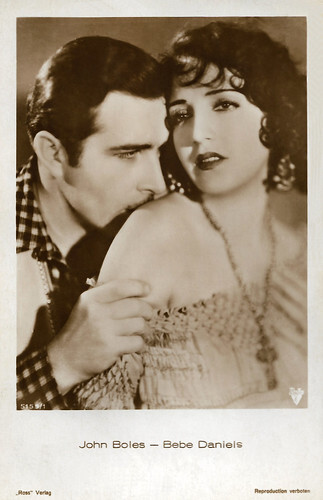
German postcard by Ross Verlag, no. 5159/1, 1930-1931. Photo: Radio (R.K.O.) John Boles and Bebe Daniels in Rio Rita (John G. Blystone, 1929).
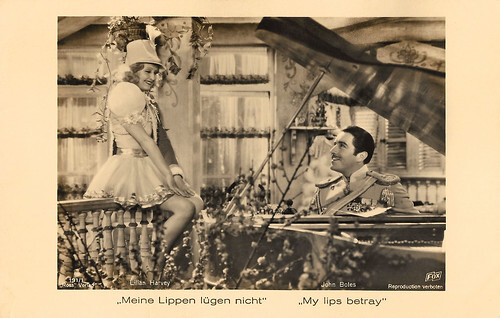
German postcard by Ross Verlag, no. 191/1, 1932-1933. Photo: Fox. Lilian Harvey and John Boles in My Lips Betray (John G. Blystone, 1933).
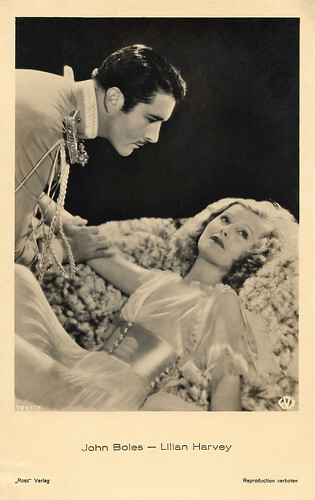
German postcard by Ross Verlag, no. 7993/2, 1932-1933. Photo: Fox. Lilian Harvey and John Boles in My Lips Betray (John G. Blystone, 1933).
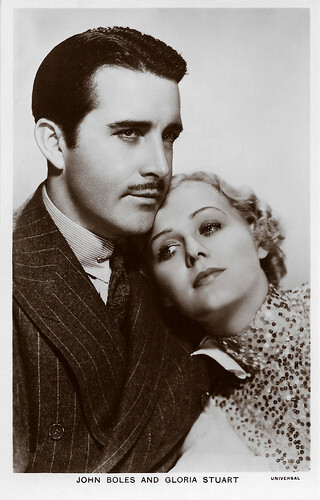
British postcard in the Film Partners Series, London, no. P 142. John Boles and Gloria Stuart in Beloved (Victor Schertzinger, 1934).
An even more extravagant musical
As soon as Rio Rita was completed, John Boles went back to Warner Brothers as the leading man in an even more extravagant musical entitled Song of the West (Ray Enright, 1930) that was filmed entirely in Technicolor. Shortly after this film, Universal Pictures offered John Boles a contract, which he accepted. He starred in a number of pictures for them, most notably the all-Technicolor musical revue entitled The King of Jazz (John Murray Anderson, 1930) and a historical operetta entitled Captain of the Guard (John S. Robertson, Pál Fejös, 1930) opposite Laura La Plante .
In 1931, he starred with Evelyn Laye in One Heavenly Night (George Fitzmaurice, 1931), which would prove to be his last major musical. Boles portrayed Victor Moritz in Frankenstein (James Whale, 1931). He starred with Irene Dunne in a film adaptation of Edith Wharton's 1920 novel 'The Age of Innocence' (Philip Moeller, 1934) for RKO Radio Pictures.
He had another leading part opposite Gloria Swanson , this time as her bickering beau in Music in the Air (Joe May, 1934) and he took the role of Edward Morgan in Curly Top (Irving Cummings, 1935), starring Shirley Temple . Freelancing after his Fox contract ended in 1936, Boles experienced a dip in popularity. Then Boles played a strong part alongside Barbara Stanwyck in the classic Stella Dallas (King Vidor, 1937).
In 1943, Boles played the role of a colonel in the star-studded Thousands Cheer (George Sidney, 1943). By this point, his film career had declined and he returned to the stage. On Broadway, he co-starred with Mary Martin and Kenny Baker in 'One Touch of Venus' (1943), a musical with music written by Kurt Weill, lyrics by Ogden Nash, and a book by S. J. Perelman and Nash. Boles retired from the screen and stage in 1952, after one more film, the low-budget farce Babes in Baghdad (Edgar G. Ulmer, 1952), wherein, according to AllMovie , he was "trapped with fellow faded luminaries Paulette Goddard and Gypsy Rose Lee".
John Boles later went into the oil business and lived the last 13 years of his life in San Angelo, Texas. For his contributions to the film industry, Boles was inducted into the Hollywood Walk of Fame in 1960 with a motion pictures star located at 6530 Hollywood Boulevard. Boles died of a heart attack in 1969, in San Angelo, Texas, at age 73. He and his wife Marcelite are interred at Westwood Memorial Park in Los Angeles. The couple had two daughters: Frances and Janet.
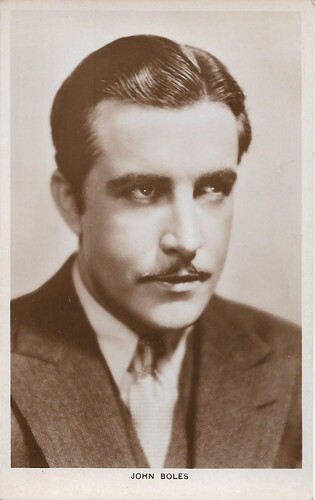
British postcard.
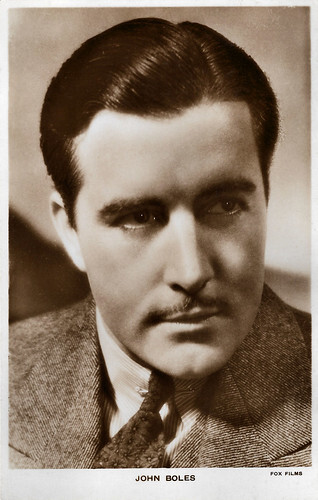
British postcard. Photo: Fox Films.
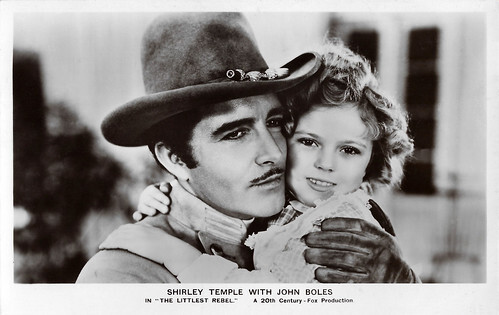
British postcard, no. FS 17. Photo: 20th Century Fox. Shirley Temple and John Boles in The Littlest Rebel (David Butler, 1935).
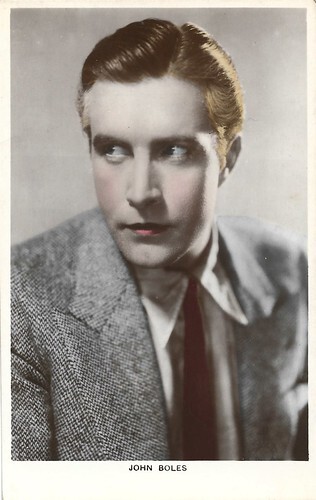
British postcard in the Colourgraph Series, London, no. C.20.
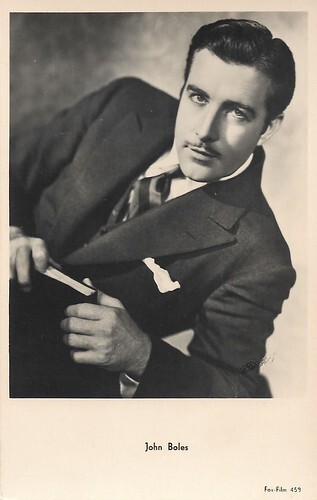
Dutch postcard, no. 459. Photo: Fox Film.
Sources: AllMovie, Wikipedia and .

French postcard, no. 727.

German postcard by Ross Verlag, no. 51592, 1930-1931. Photo: Radio Pictures (RKO). Bebe Daniels and John Boles in Rio Rita (Luther Reed, 1929).

Vintage photo. John Boles, Edward Van Sloan, Colin Clive and Boris Karloff in Frankenstein (James Whale, 1931).
Audiences were enthralled by his beautiful voice
John Boles was born in Greenville, Texas, to a middle-class family. He graduated from the University of Texas in 1917. Boles served in the intelligence service of the U.S. Army during World War I. He returned to Greenville, where he was selected by an out-of-town producer to act in an opera at the King Opera House. This experience convinced John that he preferred music and the stage to the preference of his parents, who wanted him to pursue a medical degree.
While en route to a career as an actor and singer, Boles earned a living by teaching French and singing in a high school in New York State and working as a business manager and interpreter for a one-year tour of Europe by a student group. The latter venture led to his studying under tenor Jean de Reszke. Boles married Marcelite Dobbs in 1917, and they remained married until his death.
After the First World War, Boles moved to New York to study music. He quickly became well-known for his talents and was selected to replace the leading man in the 1923 Broadway musical 'Little Jesse James'. He became an established star on Broadway. Boles' other Broadway credits include 'Mercenary Mary' (1924), and 'Kitty's Kisses' (1925). It attracted the attention of Hollywood producers.
He was hired by MGM to appear in the silent film The Sixth Commandment (Christy Cabanne, 1924). He starred in two more films for that studio before returning to New York and the stage. In 1927, he returned to Hollywood to star in The Love of Sunya (Albert Parker, 1927) opposite Gloria Swanson , which was a big success for him. Unfortunately, because the movies were still silent he was unable to show off his singing ability.
In 1929, Warner Brothers hired him to star in their lavish musical operetta The Desert Song (Roy Del Ruth, 1929). This film featured sequences in Technicolor and was a box-office success. Soon after, Radio Pictures (later known as RKO) selected him to play the leading man in their extravagant production Rio Rita (Luther Reed, 1929), opposite Bebe Daniels . The last portion of the film was photographed in Technicolor. Audiences were enthralled by his beautiful voice, and John Boles suddenly found himself in huge demand. RCA Victor even hired him to make phonograph records of songs that he had sung in his films.

German postcard by Ross Verlag, no. 4812/1, 1929-1930. Photo: Radio Pictures (RKO). Bebe Daniels and John Boles in Rio Rita (Luther Reed, 1929).

German postcard by Ross Verlag, no. 5159/1, 1930-1931. Photo: Radio (R.K.O.) John Boles and Bebe Daniels in Rio Rita (John G. Blystone, 1929).

German postcard by Ross Verlag, no. 191/1, 1932-1933. Photo: Fox. Lilian Harvey and John Boles in My Lips Betray (John G. Blystone, 1933).

German postcard by Ross Verlag, no. 7993/2, 1932-1933. Photo: Fox. Lilian Harvey and John Boles in My Lips Betray (John G. Blystone, 1933).

British postcard in the Film Partners Series, London, no. P 142. John Boles and Gloria Stuart in Beloved (Victor Schertzinger, 1934).
An even more extravagant musical
As soon as Rio Rita was completed, John Boles went back to Warner Brothers as the leading man in an even more extravagant musical entitled Song of the West (Ray Enright, 1930) that was filmed entirely in Technicolor. Shortly after this film, Universal Pictures offered John Boles a contract, which he accepted. He starred in a number of pictures for them, most notably the all-Technicolor musical revue entitled The King of Jazz (John Murray Anderson, 1930) and a historical operetta entitled Captain of the Guard (John S. Robertson, Pál Fejös, 1930) opposite Laura La Plante .
In 1931, he starred with Evelyn Laye in One Heavenly Night (George Fitzmaurice, 1931), which would prove to be his last major musical. Boles portrayed Victor Moritz in Frankenstein (James Whale, 1931). He starred with Irene Dunne in a film adaptation of Edith Wharton's 1920 novel 'The Age of Innocence' (Philip Moeller, 1934) for RKO Radio Pictures.
He had another leading part opposite Gloria Swanson , this time as her bickering beau in Music in the Air (Joe May, 1934) and he took the role of Edward Morgan in Curly Top (Irving Cummings, 1935), starring Shirley Temple . Freelancing after his Fox contract ended in 1936, Boles experienced a dip in popularity. Then Boles played a strong part alongside Barbara Stanwyck in the classic Stella Dallas (King Vidor, 1937).
In 1943, Boles played the role of a colonel in the star-studded Thousands Cheer (George Sidney, 1943). By this point, his film career had declined and he returned to the stage. On Broadway, he co-starred with Mary Martin and Kenny Baker in 'One Touch of Venus' (1943), a musical with music written by Kurt Weill, lyrics by Ogden Nash, and a book by S. J. Perelman and Nash. Boles retired from the screen and stage in 1952, after one more film, the low-budget farce Babes in Baghdad (Edgar G. Ulmer, 1952), wherein, according to AllMovie , he was "trapped with fellow faded luminaries Paulette Goddard and Gypsy Rose Lee".
John Boles later went into the oil business and lived the last 13 years of his life in San Angelo, Texas. For his contributions to the film industry, Boles was inducted into the Hollywood Walk of Fame in 1960 with a motion pictures star located at 6530 Hollywood Boulevard. Boles died of a heart attack in 1969, in San Angelo, Texas, at age 73. He and his wife Marcelite are interred at Westwood Memorial Park in Los Angeles. The couple had two daughters: Frances and Janet.

British postcard.

British postcard. Photo: Fox Films.

British postcard, no. FS 17. Photo: 20th Century Fox. Shirley Temple and John Boles in The Littlest Rebel (David Butler, 1935).

British postcard in the Colourgraph Series, London, no. C.20.

Dutch postcard, no. 459. Photo: Fox Film.
Sources: AllMovie, Wikipedia and .
Published on October 27, 2023 22:00
Paul van Yperen's Blog
- Paul van Yperen's profile
- 13 followers
Paul van Yperen isn't a Goodreads Author
(yet),
but they
do have a blog,
so here are some recent posts imported from
their feed.



